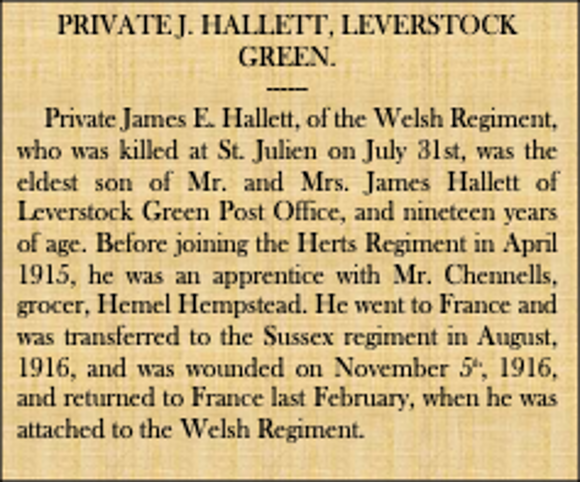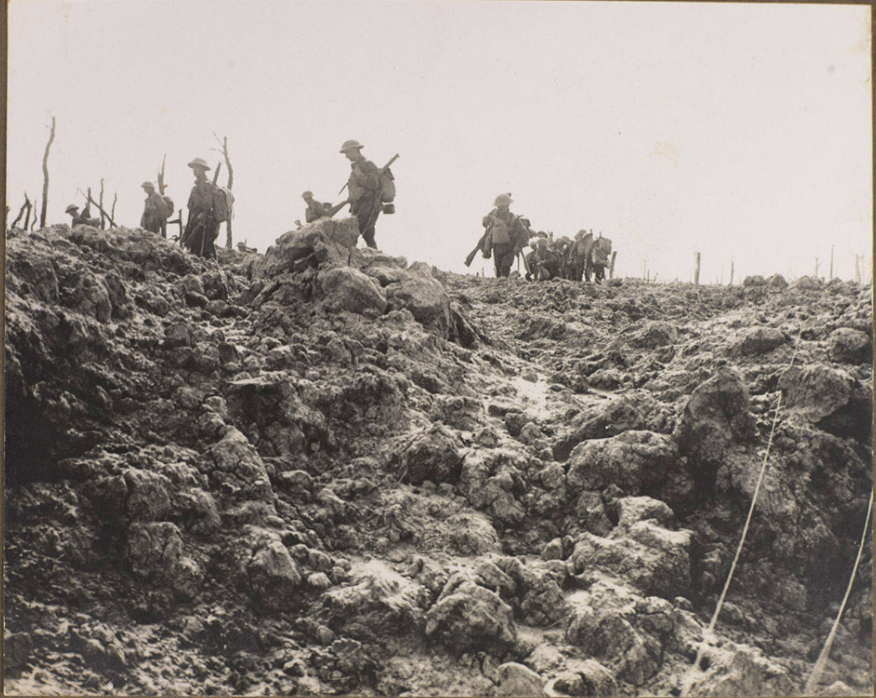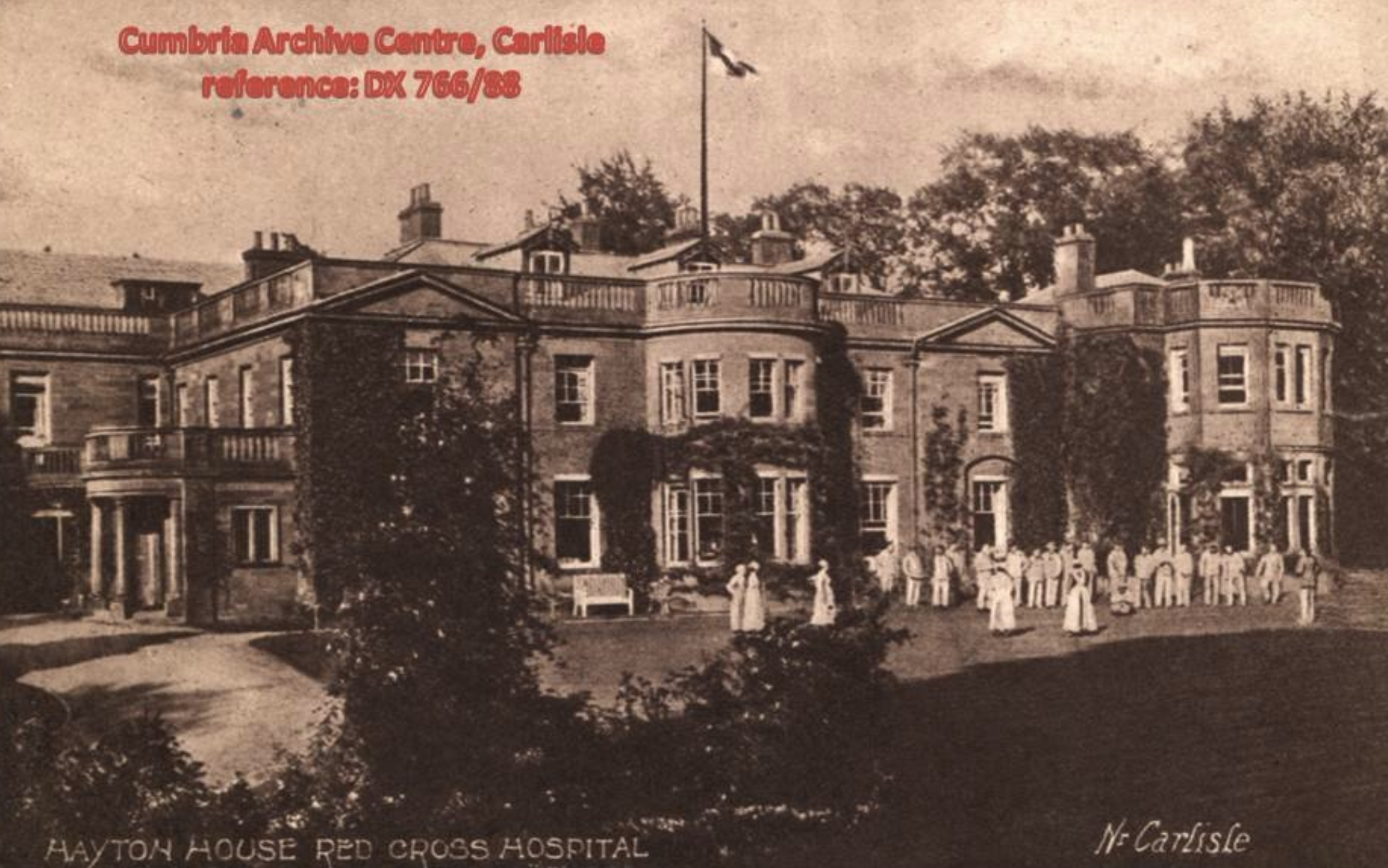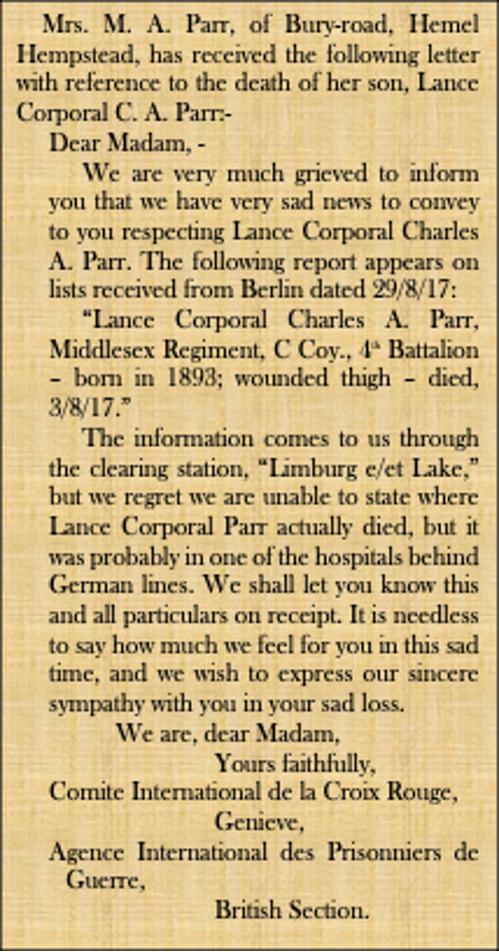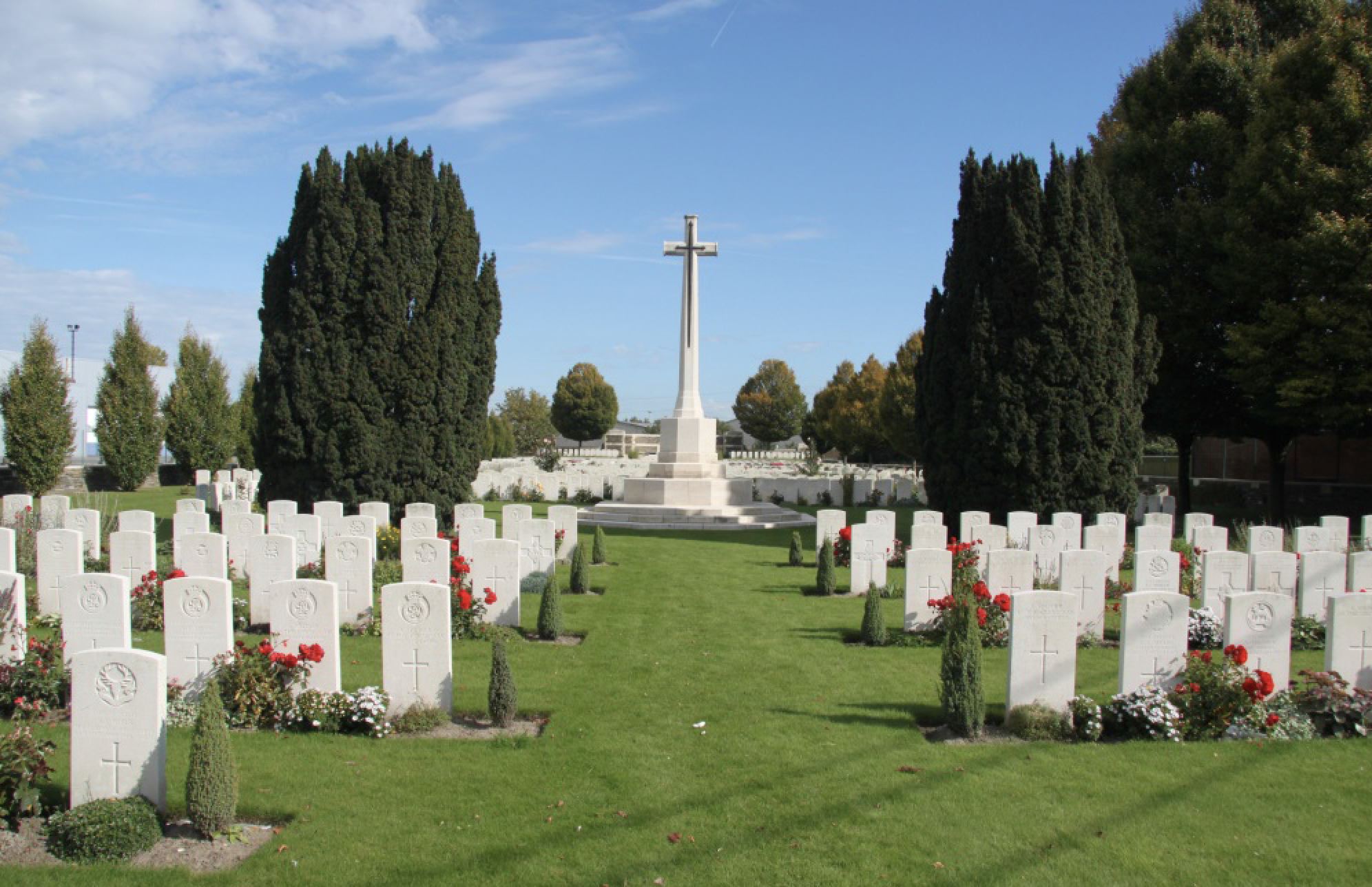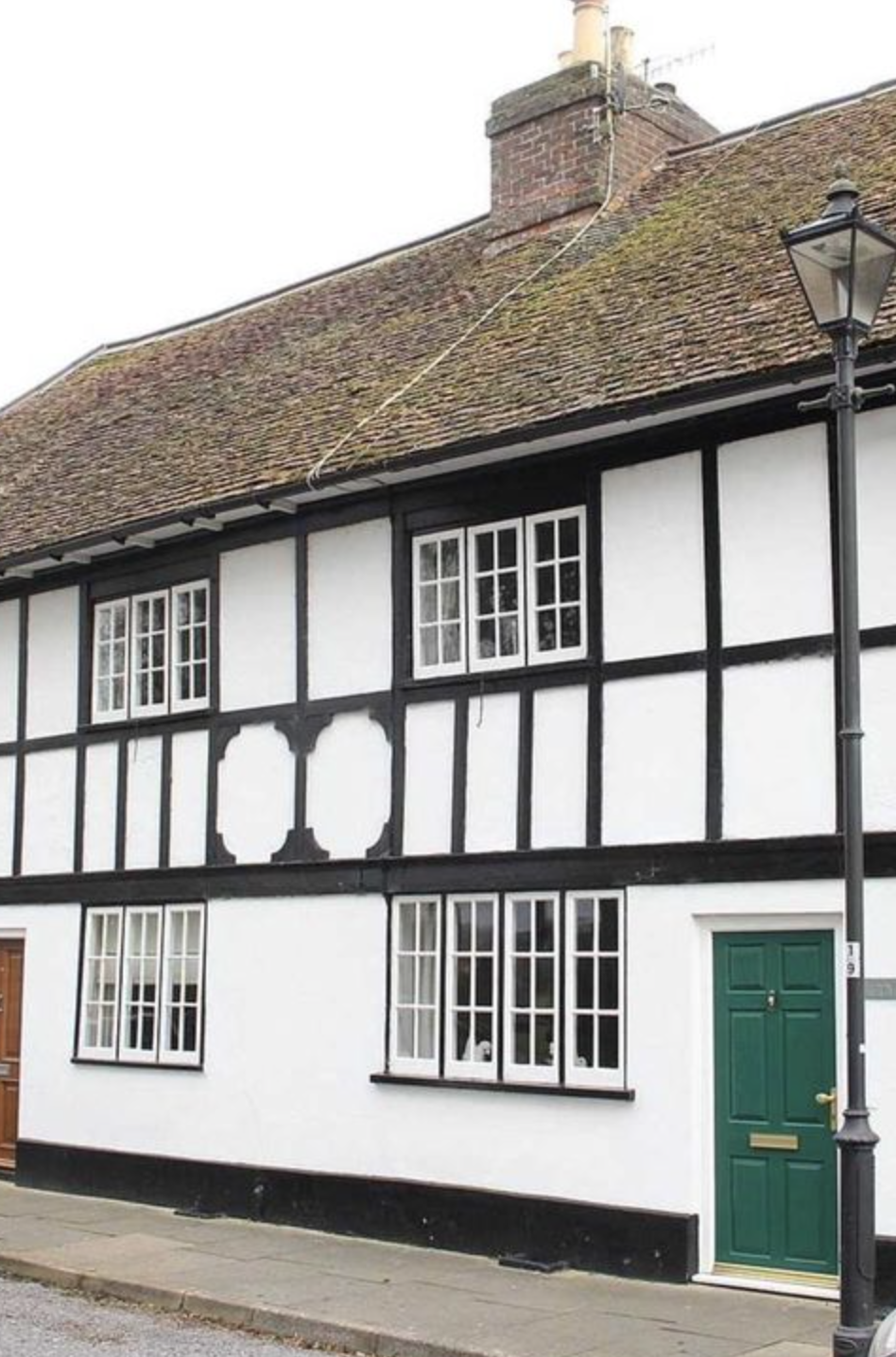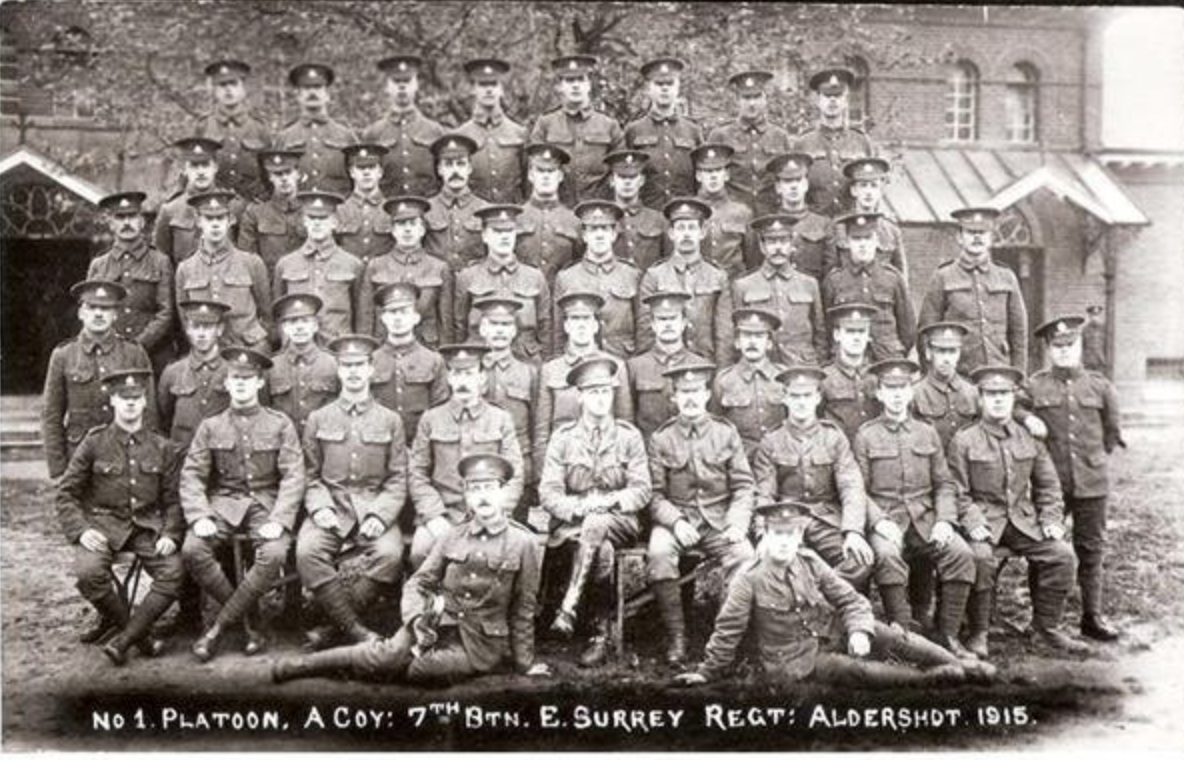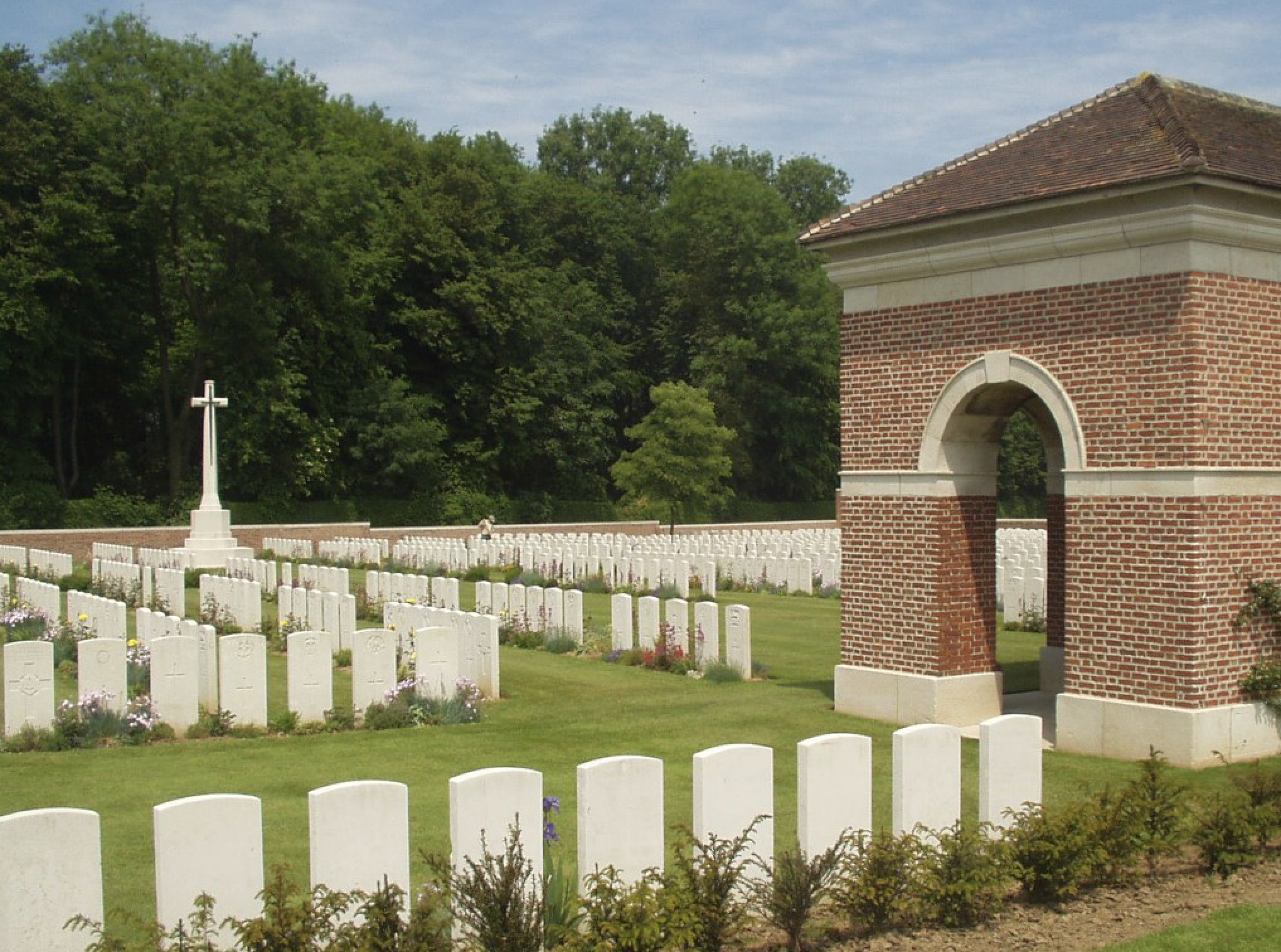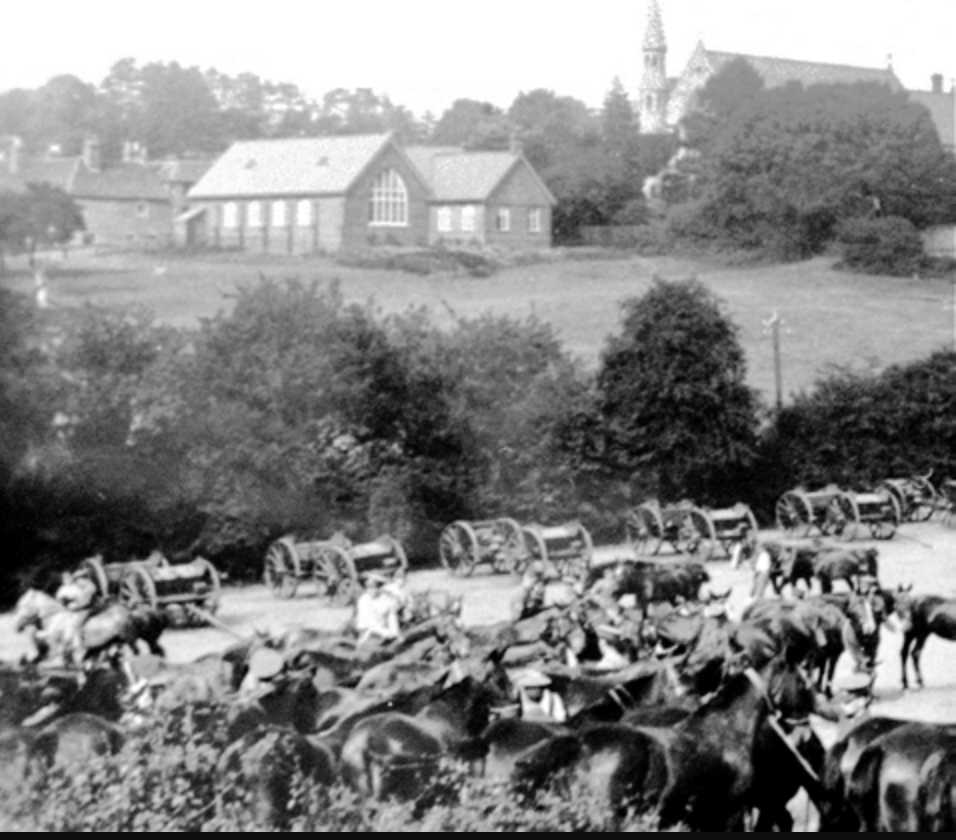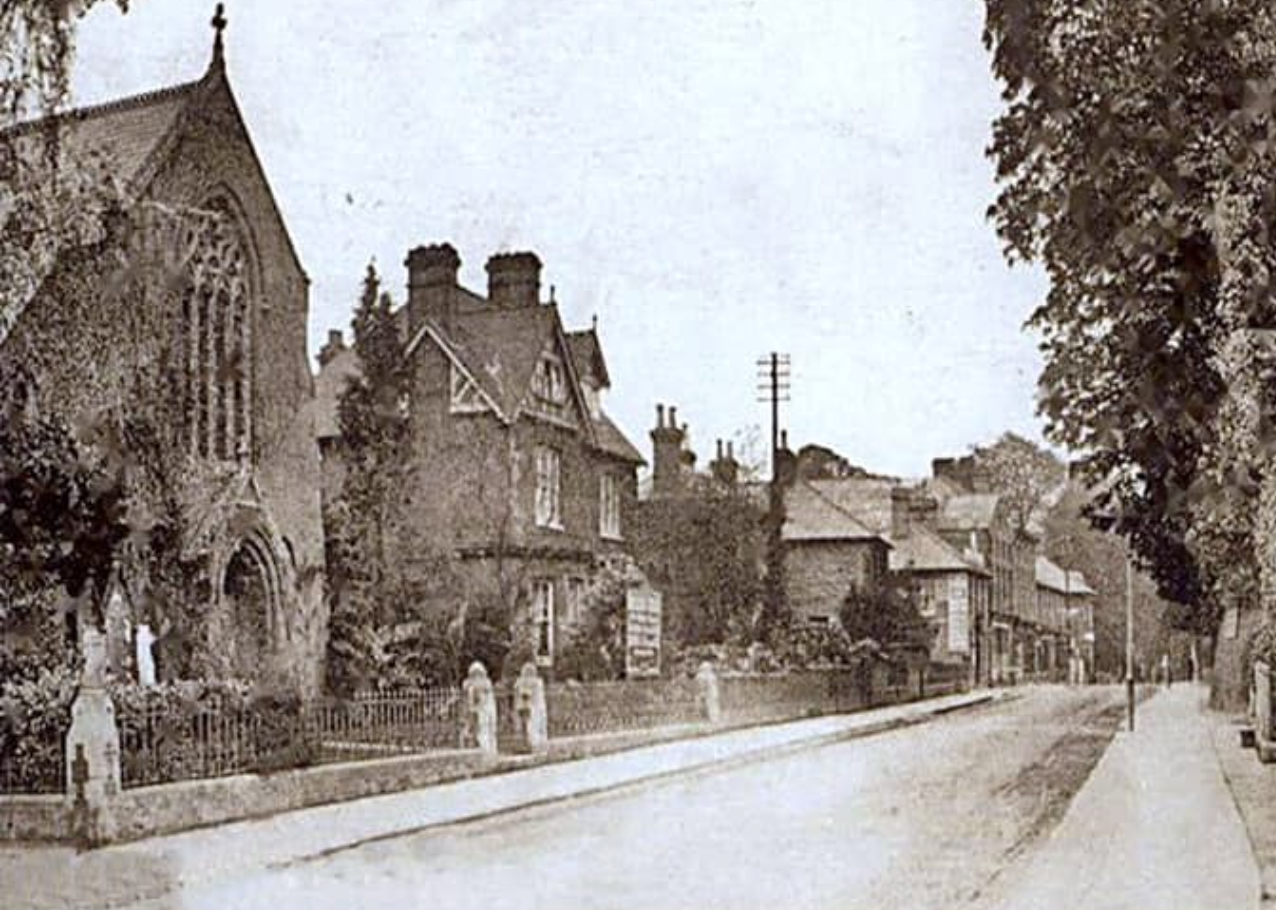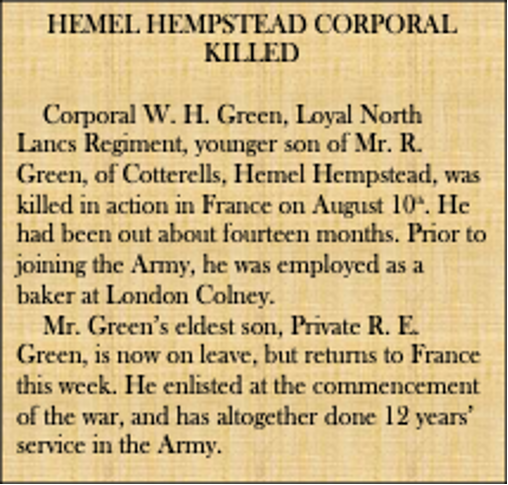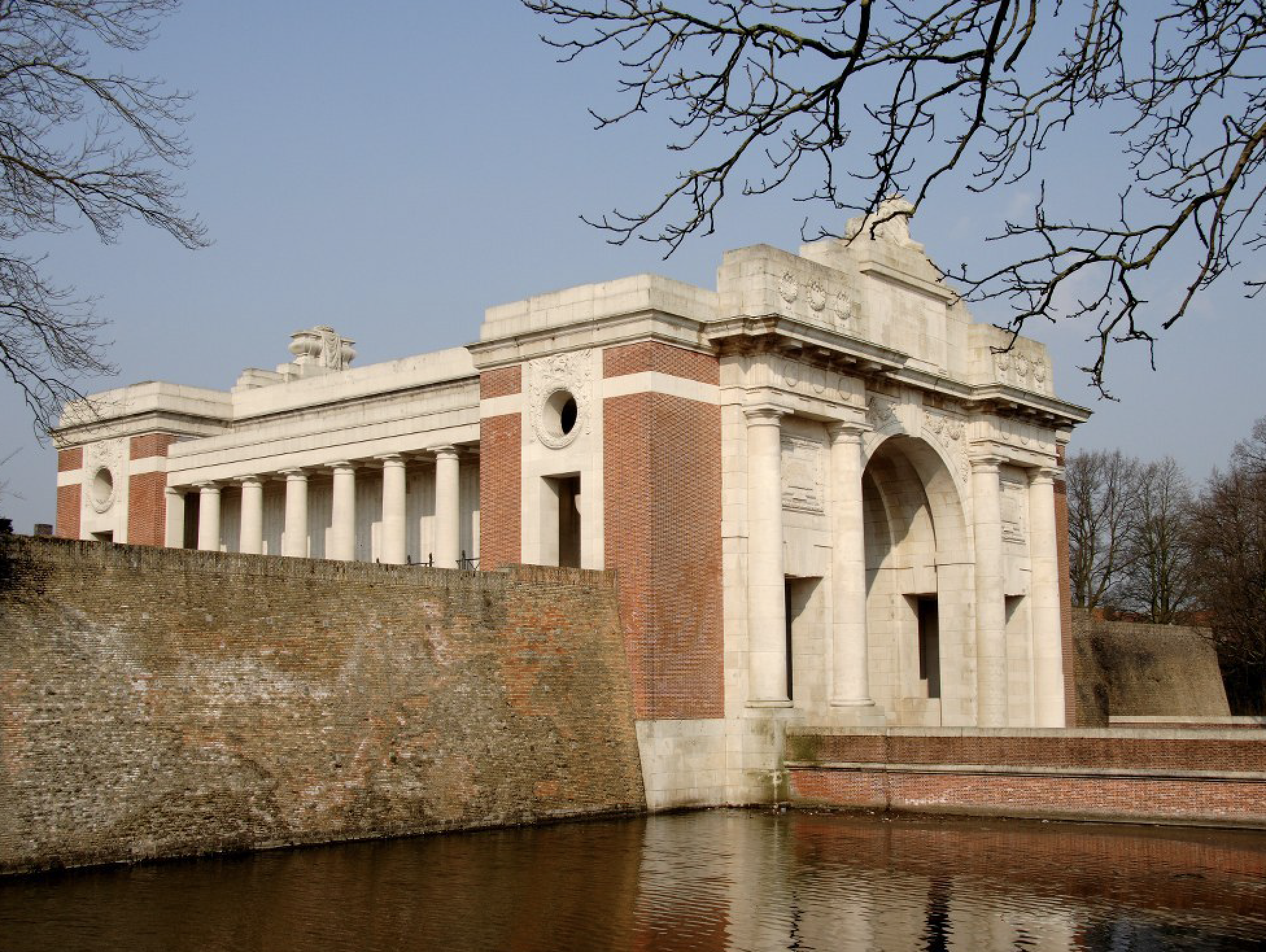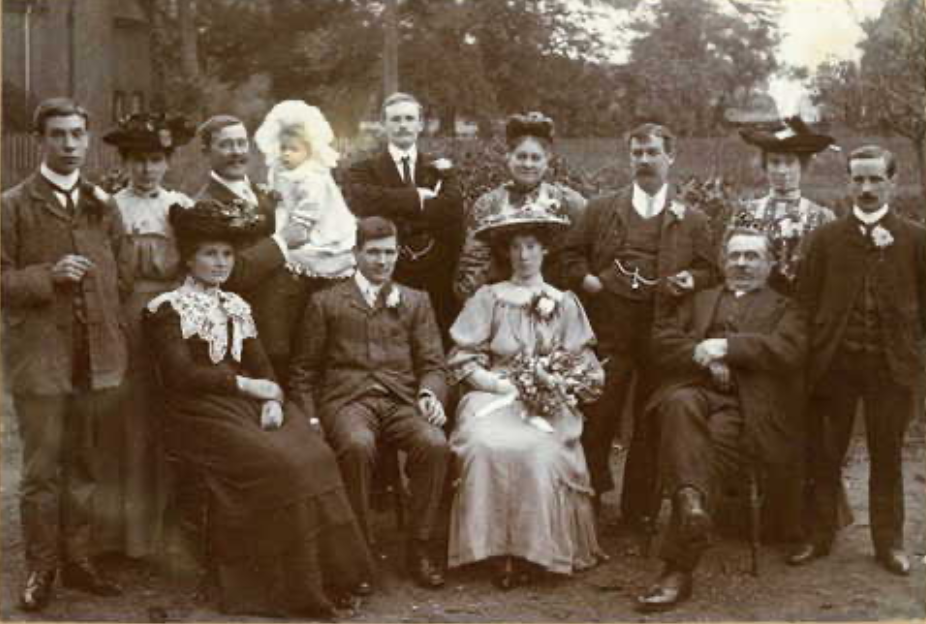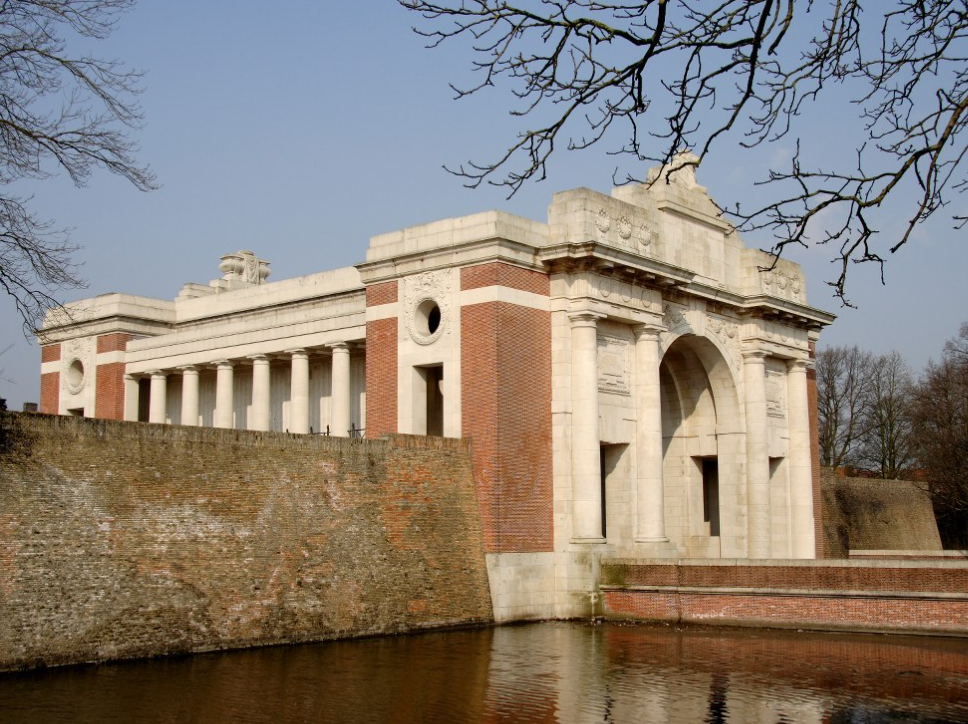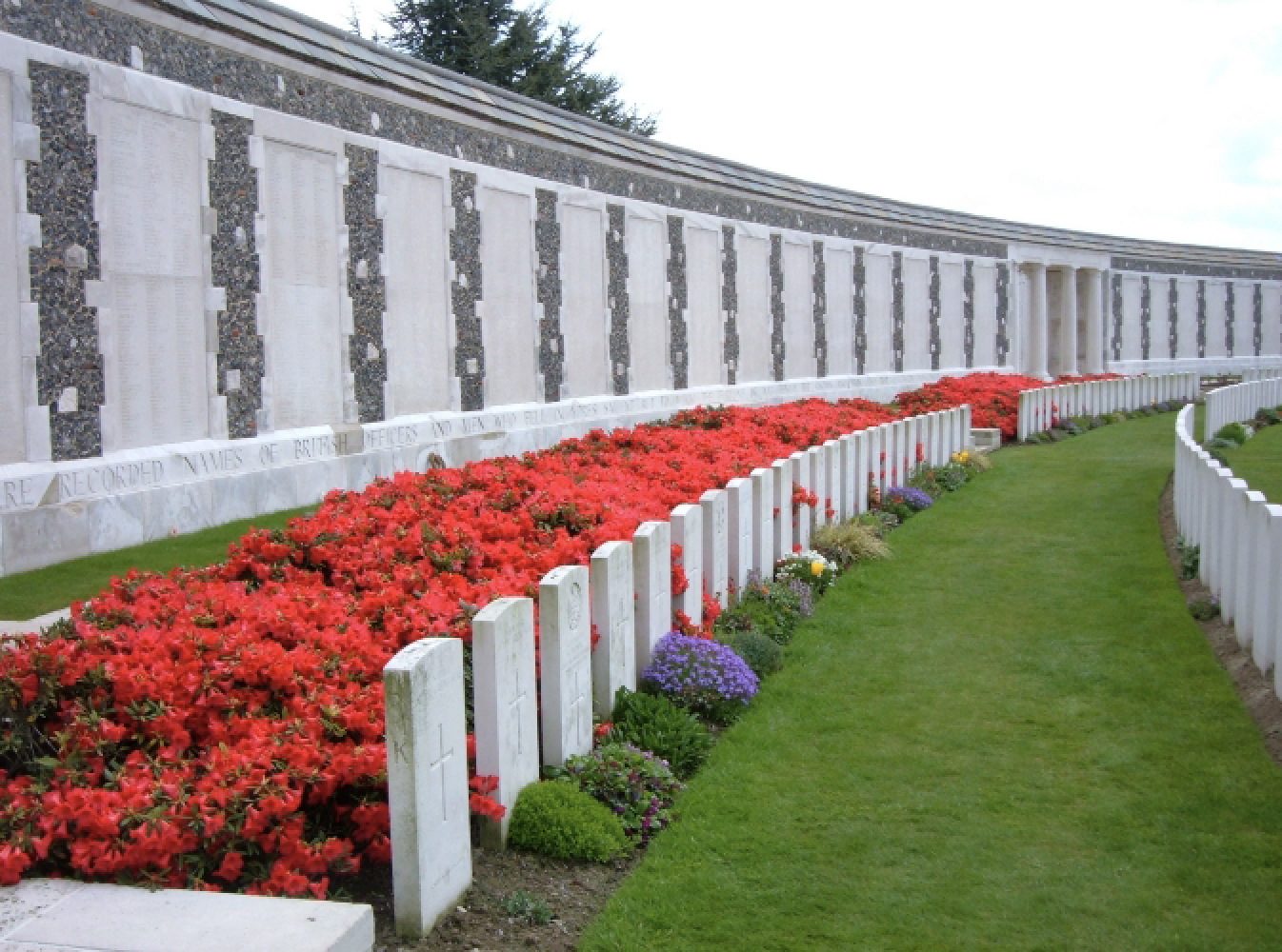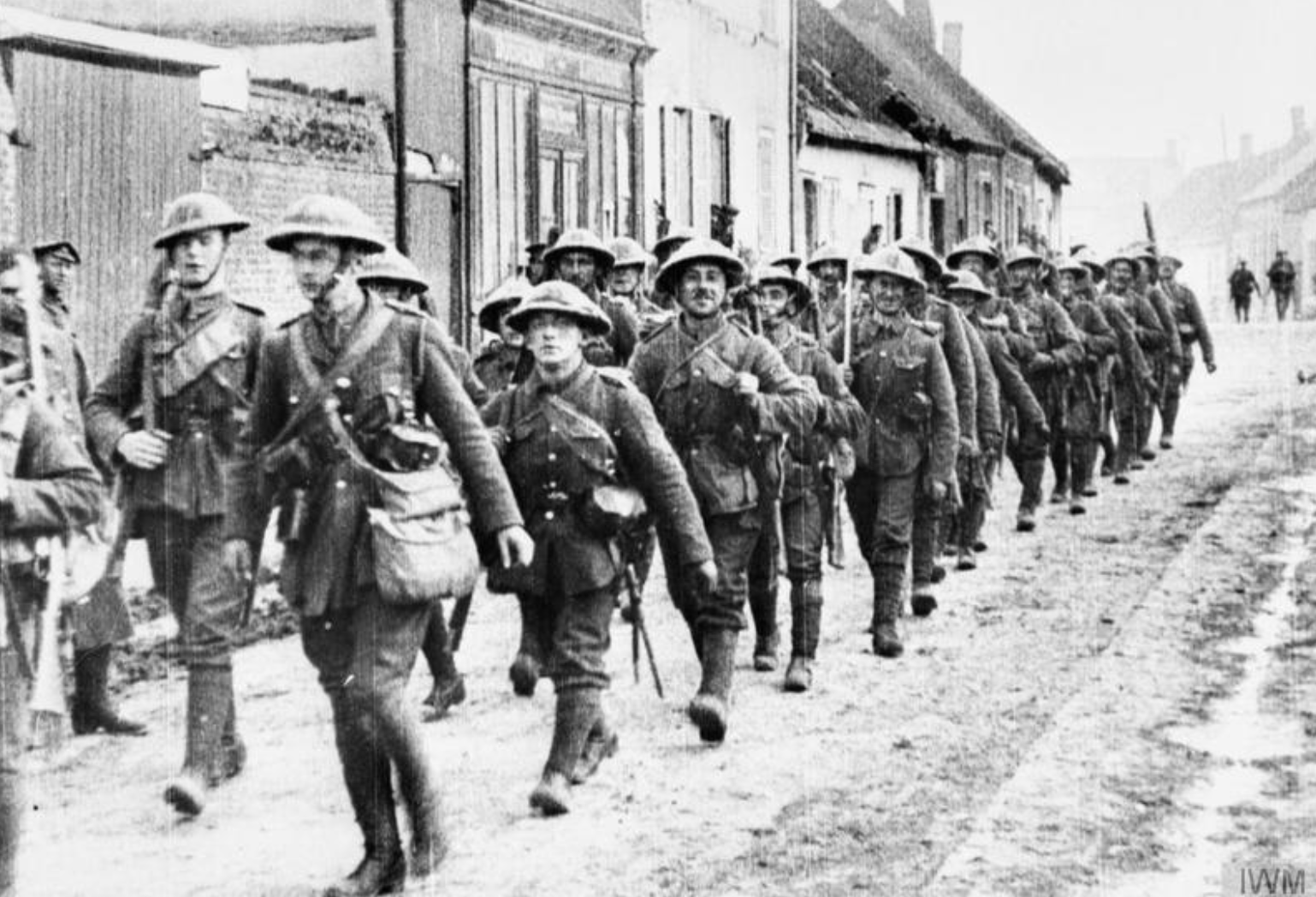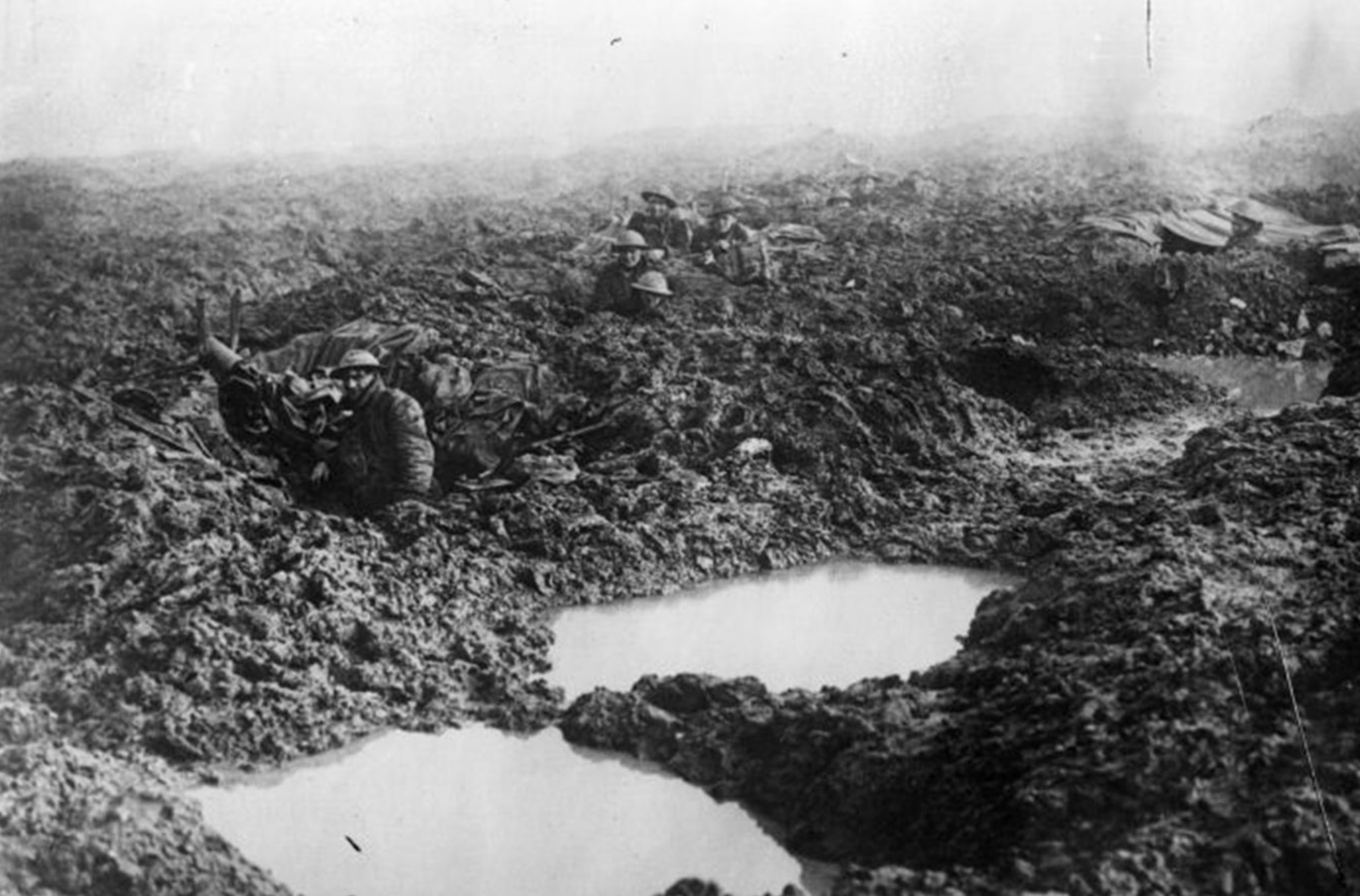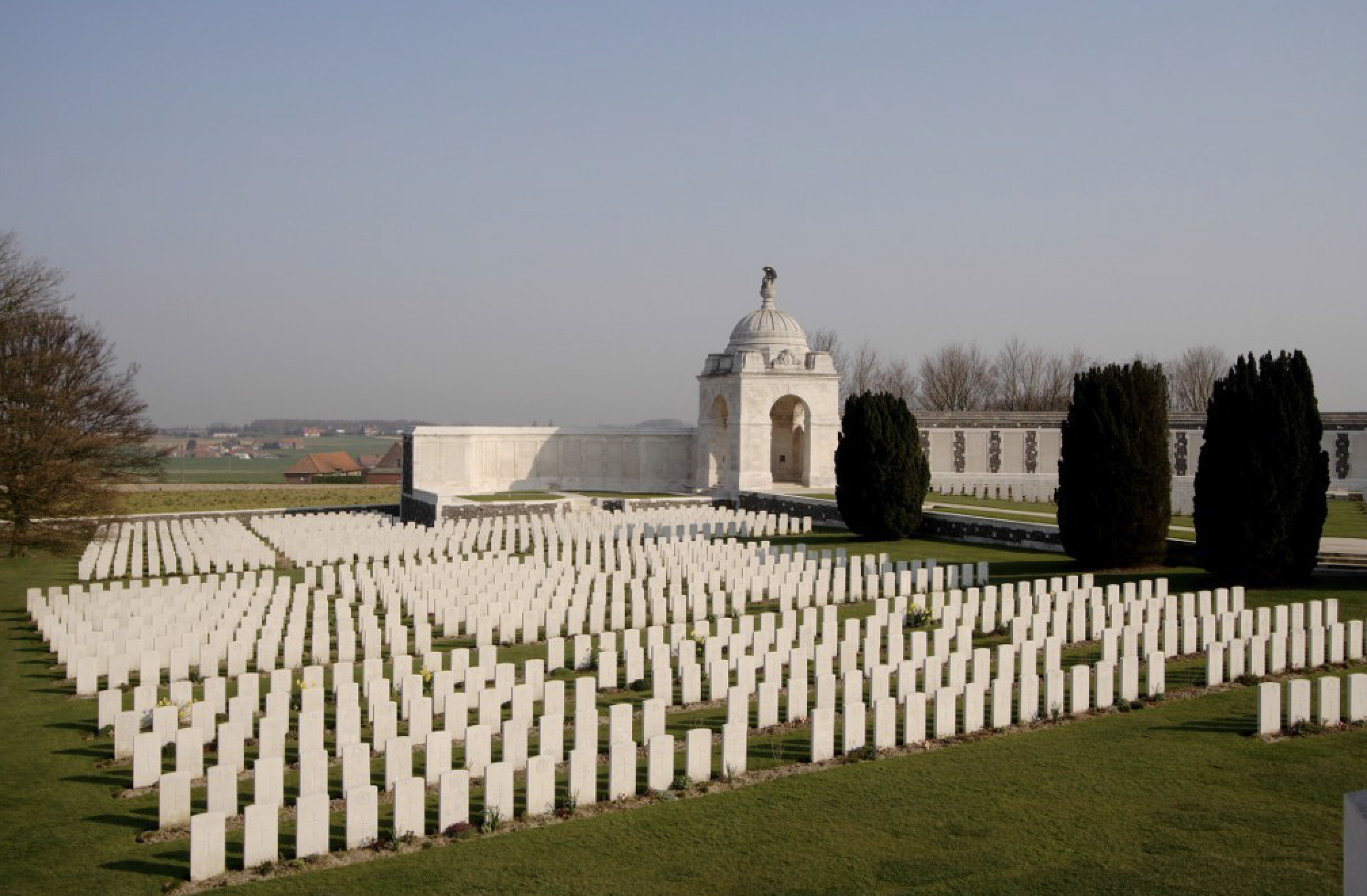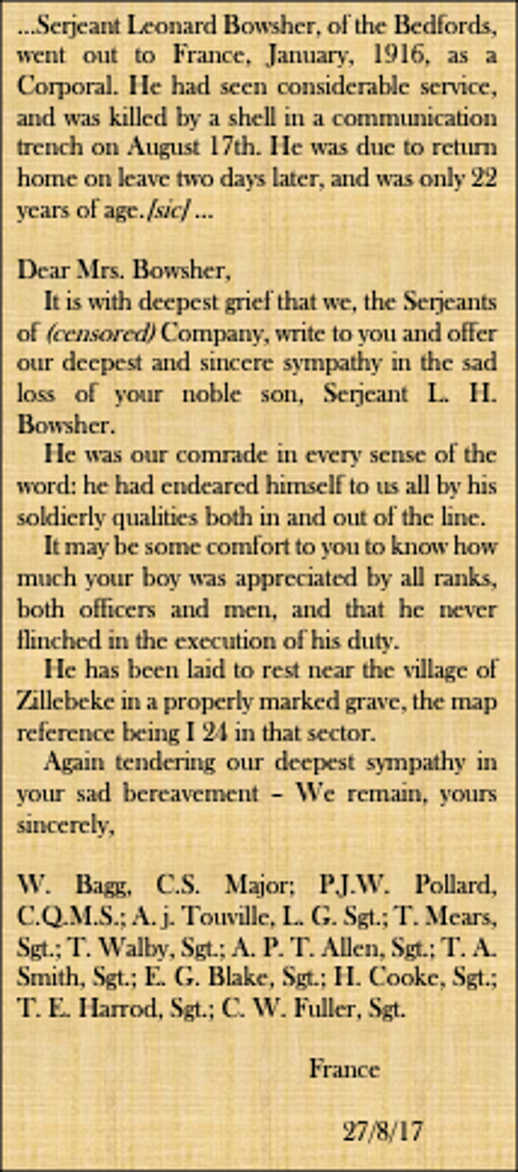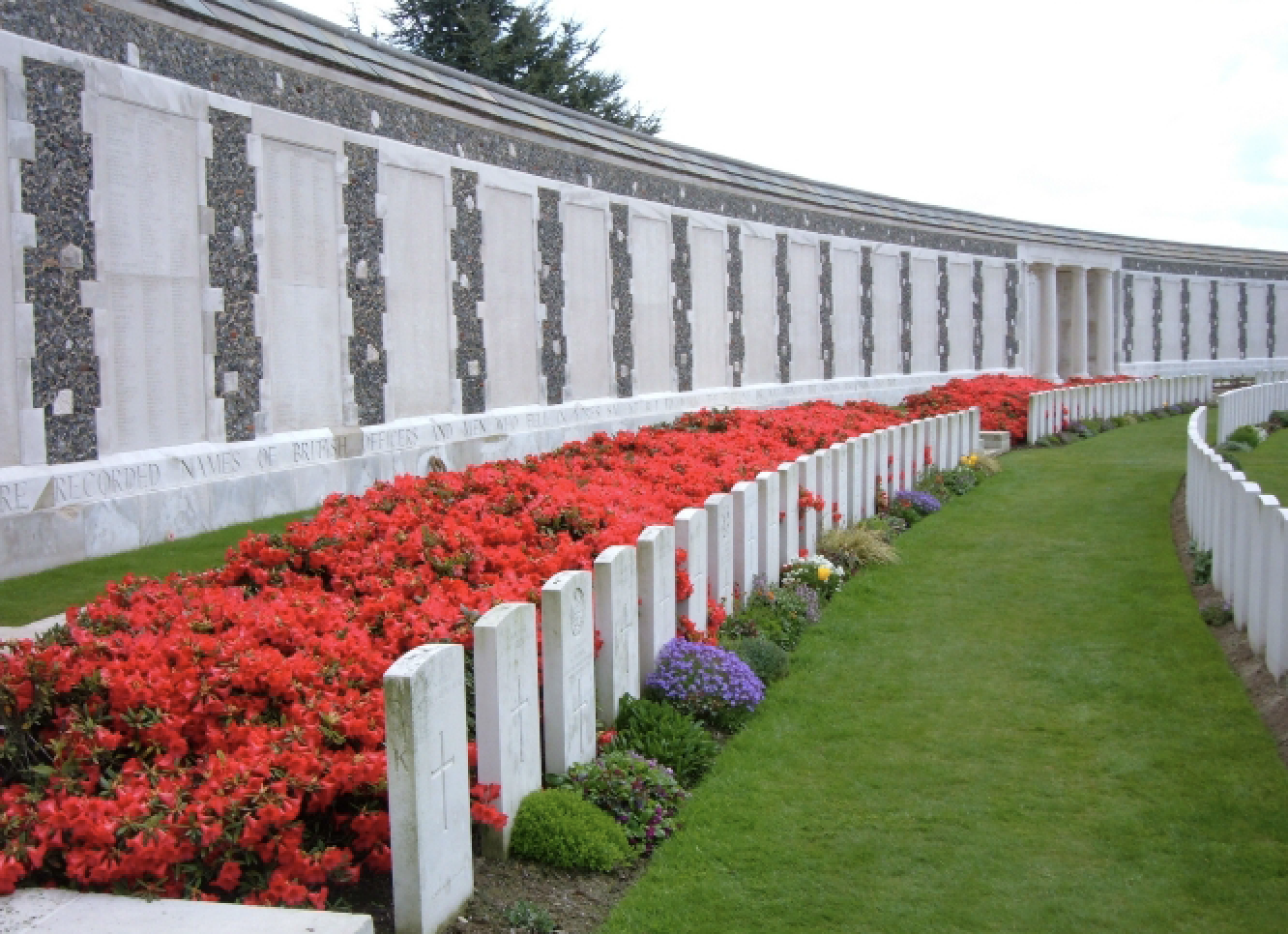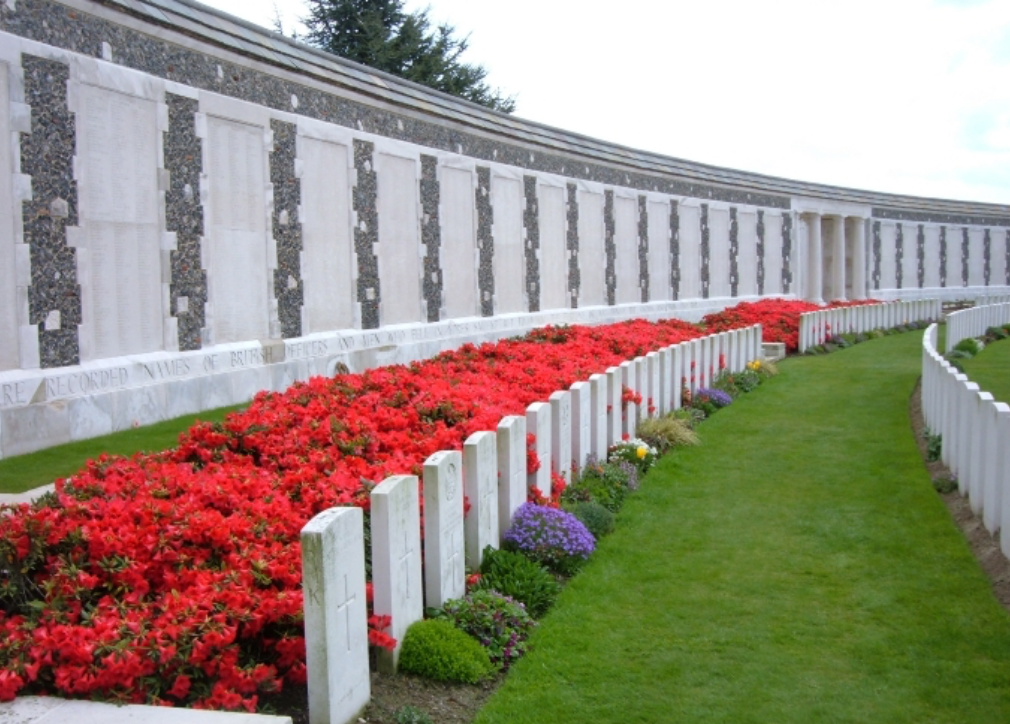Fallen in August 1917:
James Edwin Hallett
George Bates
Charles Albert Parr
Gordon Thorne
Arthur William Carrington
Harry William Green
James William Cook
William Batchelor
George Squires
Leonard H Bowsher
Albert Cutler
Frank Allum
JAMES EDWIN HALLETT
54957 Private
15th Bn., Welsh Regiment
Killed in Action Wednesday, 1st August 1917
Remembered with Honour, Artillery Wood Cemetery, West-Vlaanderen, Belgium, Grave III. F. 2.
James Edwin Hallett was born in Hunslet, a suburb of Leeds, Yorkshire on Wednesday, 10th November 1897 and baptised at the church of St. Mary the Virgin on Boxing Day in the same year. He was the eldest of three children born to James Hallett and Kate Ellen Ratcliffe and his younger siblings were George and Albert.
His brother George served with the Royal Navy during the last two years of the war and survived the conflict.
Shortly after James’ birth the family moved to Chedworth not far from Cirencester, Gloucestershire, where his father went to work as a ‘Foreman Carpenter’.
By 1908 the family had moved again, this time to Leverstock Green near Hemel Hempstead, Hertfordshire, where James and Kate had taken over the running of the village Post Office. James senior combined his postal responsibilities with licensee and landlord of the ‘White Horse’ pub in the village.
The ‘White Horse’ stood next door to the Post Office until the early sixties, when Leverstock Green underwent significant redevelopment.
James went to the local village school in Leverstock Green and when he left in 1910 aged thirteen, he was apprenticed to Adam Joseph Chennells, a ‘Grocer’ at 31 High Street in Hemel Hempstead (an Indian take-away today). Adam Chennells was a notable figure in Hemel Hempstead and had been ‘Mayor and Bailiff’ of the town in 1901-02. He continued as an Alderman on the town council for many years.
On the outbreak of war James was only sixteen, but like many young men, he was swept up in the seeming ‘glory’ of the war. In April 1915 he went to enlist, still only seventeen years and five months old. Despite being underage, he successfully joined the Colours and went to train with the Hertfordshire Regiment in Bury St. Edmunds.
In August 1916 he embarked for France where he was transferred to the 12th Battalion Royal Sussex Regiment, which had suffered so much on the eve of the Battle of the Somme.
He arrived as part of a draft of 100 men on the 5th September and was immediately engaged in trench-making, laying communications wires and spells in the front line trenches. This routine continued interspersed with training drills until early November. The Battalion War Diary records the following: “5/11/16 Battⁿ moved up into Brigade Reserve at Thiepval. The Battⁿ were occupied during early hours of the night in making a road through to Crucifix Corner…8 O.R. wounded” James was one of the unfortunate men injured, most likely by enemy shelling, as they worked.
He was evacuated down the line and came back to England to recover from his injuries. In February 1917 he went back to France following his convalescence and was transferred again, this time to the 15th Battalion Welsh Regiment.
The Carmarthenshire’s had suffered severely at the Battle of the Somme and drafts of newly trained and transferred men from other Battalions were joining to rebuild the unit strength. By June the Battalion was preparing for the attack on Pilckem Ridge, the opening encounter of the Third Battle of Ypres, or ‘Passchendaele’, which would prove so costly for all combatants.
At the end of the month James was in the trenches and the 15th Battalion incurred a large number of casualties before the planned assault began on the 31st July.
Worse followed and by the 2nd August the Battalion War Diary records the casualties during the battle: “31.7.17 to 2.8.17 Killed 15 Wounded 131 Wounded (at duty) 2 Missing 7” A total of 155 Other Ranks.
There is some confusion regarding the exact date of James’ death. All official records indicate Wednesday, 1st August 1917, however, his parents received a letter from one of his comrades that states he died on Tuesday 31st July 1917. This earlier date is the one accepted by his parents and indeed, this is the date his family recorded on his Grandparent’s headstone in 1924.
James certainly died on one of those two dates and given the immense stress in the field it is easy to understand why confusion might occur. However, given the weight of available evidence I have recorded the official date confirming James’ death on Wednesday, 1st August 1917.
James is Remembered with Honour in the Artillery Wood Cemetery, West-Vlaanderen, Belgium, where he is interred in Grave III. F. 2. The inscription on his headstone, requested by his mother Kate, reads: “GREATER LOVE HATH NO MAN THAT HE GAVE HIS LIFE FOR HIS FRIENDS”
James lies next to George Bates from Hemel Hempstead in this cemetery.
He was only 19 years old when he died.
James was eligible for the British War Medal and the Allied Victory Medal.
The Post Office and White Horse c 1950 (Photo: Leverstock Green Chronicle)
Extract from The Hertfordshire, Hemel Hempstead Gazette and West Herts Advertiser 18th Aug. 1917
Leverstock Green War Memorial (Photo: Traquair Photography)
Pte. J. E. Hallett’s Headstone (Photo: International Wargraves Photography Project)
GEORGE BATES
55229 Private
16th Bn., Welsh Regiment
Killed in Action Friday, 3rd August 1917
Remembered with Honour, Artillery Wood Cemetery, West Vlaanderen, Belgium, Grave III. F. 1.
George Bates was born in Hemel Hempstead on Tuesday, 16th October 1883 the second son and child born to Frederick Bates and Emily Hollick who had a family of nine together. The children were: William, George, Frederick, Elizabeth, Lily, Harry, Robert, Archie (Archibald) and the youngest Edith.
George grew up living in St. John’s Road in Boxmoor and attended the local school, Boxmoor JMI which he started as an infant in 1888. He moved up to the Middle school on the 5th May 1890 and when he left, on the 31st July 1897, he was still only twelve-years-old.
He immediately started work on a farm, but by the next census in 1901, George and his younger brother Frederick, had found work as a ‘Sawyers’ at Foster’s Limited, the local steam and water saw mill.
Foster’s mill and timber yard stood on Kingsland Road next to the Grand Junction (Union) Canal and provided work for many local Boxmoor men.
George married Nellie (Lilian) Mallord in 1906 and by 1911 they were living with Nellie’s step-father, Herbert Orchard, at 30 St John’s Road. George and Herbert had worked together in Foster’s sawmills and George knew Nellie long before they married.
His brother-in-law Herbert, Nellie’s half-brother, was killed only eight weeks before George and his biography also appears on this site.
George had changed jobs again by this time and now worked as a ‘Coal Heaver’ with John Dickinson & Co. Limited in Apsley Mills.
George and Nellie had four children who were: Lilian Emma born in 1908, Dorothy in 1910, Robert George in 1912 and finally, Joyce in 1916. Sadly both Dorothy and Robert died as babies in 1910 and 1915 respectively.
George was called up for the Army under the Military Service Act in June 1916 and six months later, in December, he attested at Bedford and enlisted with the Bedfordshire Regiment. He was immediately posted to undergo basic training and in April 1917 he was sent to France.
He had been transferred to the 16th Battalion Welsh Regiment, which was in the process of rebuilding following the horrific loss of much of its fighting strength at Mametz Wood in 1916. George joined his new Battalion on the 17th April at Boesinghe just north of Ypres as preparations for the next major offensive were in progress.
On the 31st July the Third Battle of Ypres began with the assault on Pilckem Ridge and over the next few days, the 16th Battalion Welsh Regiment was engaged in fighting that incurred heavy casualties. George did not survive. He had been at the Front for only three-and-a-half months and his first serious action was at Pilckem Ridge on the 31st July.
He was killed on Friday, 3rd August 1917.
George was commemorated on the John Dickinson & Co. Limited War Memorial in Apsley.
Foster’s Limited where George worked (Photo:https://www.hertsmemories.org.uk)
Pilckem Ridge where George died (Photo: National Army Museum, Online Collection)
John Dickinson & Co. Limited War Memorial, Apsley (Photo:Traquair Photography)
Artillery Wood Cemetery, West Vlaanderen, Belgium (Photo:CWGC)
George is remembered with Honour in Artillery Wood Cemetery, West Vlaanderen, Belgium where he is interred in Grave III. F. 1.
He lies next to James Edwin Hallett from Leverstock Green in this cemetery.
He was 33 years old when he died.
George was eligible for the British War Medal and the Allied Victory Medal.
CHARLES ALBERT PARR
G/12070 Lance Corporal
4th Bn., Middlesex Regiment
Died of Wounds Friday, 3rd August 1917
Remembered with Honour, Harlebeke New British Cemetery, West-Vlaanderen, Belgium, Grave XIV. D. 16.
Charles Albert Parr was born in Hemel Hempstead early in 1893 the fourth child of Walter Parr and his second wife Mary Ann who had five children together. Charles had two half-brothers from his father’s first marriage, Herbert Henry and Walter. His full siblings were: Mary Jane Susan who was older and Ernest William, Emily Margaret and Lilian who were younger.
His younger brother Ernest served with the 4th Northamptonshire Regiment and was a POW in Suez, Egypt. He survived the war.
Charles’ father Walter died in 1898 and left his mother Mary Ann with five children under the age of nine. As a result Mary Ann went out to work and found a job as a ‘Charwoman’ and on the meagre wages from her work she raised her family
Charles left school in 1906 and immediately went to work as a ‘Brush Maker’, with G. B. Kent & Sons Ltd. in Apsley. He was still there on his eighteenth birthday in 1911 but by 1915 he had left and moved to Stanmore, Middlesex where his address was given as 3 Chart Cottages, Green Lane and he worked as a ‘Gardener’.
He attested at Watford under the ‘Derby’ (Group) Scheme on 17th November 1915 where he was deemed fit for general service and assigned to ‘Group 5’ based on his year of birth. He was assigned to the Army Reserve and given a call up date of the 22nd January 1916, when he returned to report for active service.
He enlisted at Mill Hill with 11th Battalion, Duke of Cambridge’s Own (Middlesex Regiment) and later transferred to the 4th Battalion. His service records give the following details about Charles: At 5 feet 5½ inches he was taller than average, had a 37 inch chest and weighed 129 lbs (9 st 3 lbs). His medical records state that Charles had lost his teeth and wore a false set. Ths was not unusual for the time and would have been seen as an advantage by the forces. Dental problems and tooth decay affected almost 90% of all enlisted soldiers during the war and often took them out of the line due to painful complications.
Charles was initially posted to Chatham to train and on the 19th May 1916 he was sent to France. The 4th Battalion Middlesex Regiment were under the orders of the 63rd Brigade in the 21st Division and fought at the Battle of Albert during the bloody opening of the Somme Offensive on the 1st July.
Between the 1st and 3rd July Charles experienced the horrors of war for the first time and was fortunate to come through unscathed, although many of his comrades did not. The Battalion War Diary records the casualties as follows: "Officers Killed – 15; Officers Wounded – 4; O.R. Killed – 131; Wounded – 337; Missing believed killed - 15; Missing – 38"
This represented just over half Battalion strength and five days later on the 8th July, the 4th Middlesex was transferred to the 37th Division and Charles and his comrades did not see serious action again until the last Battle of the Somme at Ancre in November 1916.
Charles, now acting Lance Corporal received a leg injury in January 1917, which may have been as the result of an accident as no casualites are recorded in December or January. Nevertheless, Charles was evacuated back to England on the 4th January 1917 and spent thirty-six days in Hayton House hospital in Carlisle being treated and recovering.
He left hospital on the 9th February and came back to Hemel Hempstead and his mother to convalese, before finally returning to France on the 30th March and re-joining his unit twenty days later. His return coincided with his promotion to Lance Corporal confirmed.
Charles was in action immediately fighting through the Arras Offensive in May and by July he had moved with his comrades to a position north of Ypres when the Battalion prepared for an attack at Pilckem Ridge.
This battle was the opening engagment in what became known as the Third Battle of Ypres or Passchendaele. Pilckem was again a costly action for the allies and the 4th Middlesex was no exception. The Battalion War Diary records 210 casualties which included Charles who was posted missing on the 31st July 1917.
It was not until September 1917 that Charles’ fate was confirmed, when the Geneva Red Cross wrote to his mother confirming that he had died from wounds whilst in hospital as a German Prioner of War. The contents of the letter were published in the Hemel Gazette. (see extract)
It was later communicated that he died as a result of grenade splinters in his thigh at Wevelgem in Belgium.
Soldiers going "over the top" at the Somme (Photo: Library and Archives Canada)
Hayton House Hospital, Carlisle (Photo: Cumbria Archive Centre)
Extract from The Hertfordshire, Hemel Hempstead Gazette and West Herts Advertiser 20th Oct. 1917
Harlebeke New British Cemetery, West-Vlaanderen, Belgium (Photo: CWGC)
Charles died on Friday, 3rd August 1917.
Charles is remembered with Honour in Harlebeke New British Cemetery, West-Vlaanderen, Belgium, where he is interred in Grave XIV. D. 16.
He was 24 years old when he died.
Charles was eligible for the British War Medal and the Allied Victory Medal.
GORDON THORNE
3558 Private
7th Bn., East Surrey Regiment
Died of Wounds Sunday, 5th August 1917
Remembered with Honour, Tilloy British Cemetery, Tilloy-Les-Mofflaines, Pas-de-Calais, France, Grave I. J. 10.
Gordon Thorne was born in Great Missenden, Buckinghamshire in the Summer of 1885, the second son and fourth child of William Thorne and Annie Cox who had nine children together. The children were: Harriet Annie, Margaret, Colin, Gordon, William, Mabel, Noel, Harold and Leonard.
Gordon’s brother William served with the Royal Field Artillery in the Great War and survived the conflict.
William Thorne was a ‘Coachman’ and in 1891 he lived with his family at 50 Piccott’s End next door to the Smeathman family, who’s sons Julian and Cecil died on the same day in the Great War.
By 1901 the family had moved to 62 Cotterells, Hemel Hempstead and fifteen-year-old Gordon was working as a ‘Moulder’s Apprentice’ in the nearby Boxmoor Iron Works on the Marlowes.
When he reached his eighteenth birthday in 1904, Gordon enlisted with the 2nd Hertfordshire Volunteers to supplement his wages. The 2nd Herts were a teriitorial force and a battalion of the Bedfordshire Regiment and Gordon signed up for four years. In 1908, his service completed, he re-enlisted with the Territorials, this time with the 4th East Anglian Brigade, Royal Field Artillery for another period of four years.
On the outbreak of war, Gordon was living in Kilburn, Middlesex and he voluteered immediately and enlisted with the East Surrey Regiment. He was posted to 2nd Battalion to train and subsequently went to France on the 27th April 1915 and joined the Battalion at Zonnebeke on the 30th.
He was transferred with thirty other experienced ‘old’ soldiers, to the 7th (Service) Battlion East Surreys, one of Kitchener’s ‘new armies’ formed for the hostilities. He joined his new comrades in September 1915 near Armentieres and he now came under the orders of the 37th Brigade in the 12th (Eastern) Division.
He arrived just in time to fight in the Battle of Loos in late September and the actions at the Hohenzollern Redoubt, where the 7th East Surreys incurred heavy casualties. The Battalion War Diary recorded the following: “13th – 14th October…56 other ranks were killed and 156 wounded & 33 missing of which it is hoped will subsequently be brought in wounded. …”
By June 1916, Gordon was at the Somme as prepartions were underway for the impending offensive. On the 2nd July he went into action at the Battle of Albert, mercifully because the 37th Brigade attacked at nght, the casulties incurred were significantly lower than the previous days advance over no-man’s land. In all, the Brigade suffered 1090 casualties of which fifty-three were from the East Surreys.
The 7th East Surreys quickly developed a reputation as an efficient and reliable fighting unit and the Battalion War Diaries record a letter recieved on 12th July from G.O.C. 36th Infantry Brigade, General Boyd Moss as follows: "12th July, 1916. Dear Cater, I have been trying to get to see you to thank you for the excellent work done by the East Surreys when they came out to help me in OVILLIERS. They are a top-hole lot, and did splendidly. I never had a moments anxiety after they arrived. Will you please thank Col. Baldwin for me and tell him how much his services were appreciated. Yours sincerely, L. Boyd Moss."
From the 23rd July, Gordon was again in action as the Battle of Pozières was fought. This action continued with numerous attacks through August and into early September before there was any respite for Gordon and his comrades.
In 1917, Gordon and the East Surreys fought in the Battle of Arras beginning with the First Battle of the Scarpe on the 9th April when casualties were again heavy. The Battalion suffered 181 men Killed, Wounded and Missing, just over twenty-one percent of the dwindling Unit strength, which by the 10th April was down to 674 men in total.
The Second Battle of the Scarpe came next for Gordon, when on the 3rd and 4th May he fought with his comrades in attacks which again came at a heavy cost for the 37th Brigade and the 7th East Surreys. Approximately 250 men were casualties in the action which Gordon came through unscathed.
June proved a relief for the East Surreys and the men of the 37th Brigade which, rather bizarrely, held a Sports Day on Sunday, June 3rd which included: boxing, athletics and a drum competition. This was followed two days later by the Brigade ‘Horse Show’. No doubt all of this was a welcome diversion from the recent mayhem of battle.
On the 13th June the 7th Battalion East Surreys held an ‘Assault at Arms’ competition which, as well as promoting relaxation, had the practical training objective of drilling, bayoneting, marching and rapid loading tests for the men.
The lull in the action continued through July and into August when Gordon and his comrades were in reserve at Monchy.
They came under enemy shelling on a number of occasions between the 2nd and 4th of the month and it was during one of these barrages that Gordon’s luck finally ran out.
On the 4th August he was one of three men wounded when they were acting as ‘Scouts’ in a forward position. This was a duty which involved observing and sniping and came with obvious risks. Gordon was taken down the line to a Casualty Clearing Station and it was there that he succumbed to his wounds.
No.50 Piccotts End where Gordon was born (Photo: Traquair Photography)
Boxmoor Iron Works where Gordon started his working life (Photo: Public Domain)
Platoon of 7th East Surreys at Aldershot 1915 (Photo: Great War Forum)
Tilloy British Cemetery, Tilloy-Les-Mofflaines, Pas-de-Calais, France (Photo: CWGC)
Gordon died on Sunday, 5th August 1917.
Gordon is remembered with Honour in Tilloy British Cemetery, Tilloy-Les-Mofflaines, Pas-de-Calais, France, where he is interred in Grave I. J. 10. The inscription on his headstone, requested by his mother Annie, reads: “IN MEMORY EVER DEAR.”
He was 32 years old when he died.
Gordon was eligible for the 1914-15 Star, the British War Medal and the Allied Victory Medal.
ARTHUR WILLIAM CARRINGTON
16430 Guardsman
2nd Bn., Coldstream Guards
Died of Wounds Friday, 10th August 1917
Remembered with Honour, Etaples Military Cemetery, Pas-de-Calais, France, Grave XXV. M. 15A.
Arthur William Carrington was born in Hemel Hempstead in March 1883 and baptised on Wednesday, 20th June of the same year at St Mary’s Church in the town. He was the fourth son of James Carrington and Ellen Puddephatt who had a family of eight children together. Arthur’s siblings were: Susan, James, Jennie (Jane), William and Alfred who were older and his younger brother Jack (John). His oldest sister Susan died in infancy in 1878 and his brother William died in 1912 at the age of thirty-seven. Two other children died young and his father died in 1912 aged eighty-one.
Arthur’s brothers James and Alfred served in the Bedfordshire Regiment and survived the War.
In 1891, the Carrington family lived at Bennett’s End, between Leverstock Green and Apsley and Arthur’s father James worked as a ‘Farm Labourer’. Shortly after this date the family moved to Hemel Hempstead and set up home at 15 Cherry Bounce, just off the High Street.
Young Arthur by now had left school and found work as a ‘Farm Labourer’ working for Mr Howe the owner of Handpost Farm. The farm was a few minutes walk from Arthur’s home and was located on the junction of Queen Street and St Albans Road (now Queensway and Lower Adeyfield Road). A petrol station stands on the site of the farm buildings today.
Handpost Farm where Arthur worked after leaving school in 1896
When he was seventeen in 1898, Arthur enlisted in the army joining the 4th Battalion Bedfordshire Regiment a Militia unit at the time (forerunner of the Territorial Force). Arthur like many unskilled workers joined the army to supplement his farm labourers wages.
He trained with the Regiment and attended two annual camps until January 1900, when he was embodied for service overseas aged nineteen. He went to Dublin where the 2nd Battalion Bedfordshires, a regular army unit, was stationed and preparing to depart for South Africa and the Second Boer War. Arthur attested and joined the Militia Reserve on the 17th February 1900 and just ten days later set sail for South Africa.
Up until this point his conduct in the army was considered to be good. But in 1901 during his active service, Arthur was subject to a number of punishments which became increasingly more serious, culminating in 56 days imprisonment. The misdemeanour is not recorded, but it was the start of what became a theme of his army career. He was disembodied in 1902 at the end of the Second Boer War and returned to England, where he was discharged from the army in 1904 his time having expired.
Arthur married Annie Forsdick who was a native of Abbots Langley, Hertfordshire and worked for John Dickinson & Co. Limited in Apsley Mills when they met. Annie’s father Benjamin was the landlord of the Anchor pub (now a private dwelling) on Chipperfield Common near Kings Langley.
Their wedding took place in ‘Marlowes Chapel’, (the Wesleyan Methodist Church), on Sunday, 10th June 1906 and they moved into 28 Cherry Bounce close to Arthur’s parents. They had two children, though sadly neither infant survived. Their first child Edward was born in late 1909 but died shortly after birth. A second child died at birth before the 1911 Census.
On the outbreak of war Arthur immediately re-enlisted with his old regiment and was posted to Aldershot for training and mobilisation. However, his time with the Regiment was remarkably short and only eight-one days after his re-enlistment, he was discharged as an ‘undesirable’ as his previous disciplinary problems in the service resurfaced. On two separate occasions he had been punished, first for using "abusive" language to the Company Serjeant Major and then at Liphook, he was accused of “improper conduct and using obscene language in billets”. No further details are known, but it was considered of such severity that an experienced soldier was discharged just when most needed.
It seems to have been a family trait because his brother Alfred was improsioned and punished on a number of occasions during his military service, once for disobeying an order and stirking an N.C.O.
Undeterred and probably unrepentent, Arthur sought another Regiment and in July 1915 he attested again, this time in Watford, and joined the Coldstream Guards. We have a description of Arthur at the time of his enlistment as follows: Aged "34 years and 6 months" (he was actually a year younger); "Height: 5 feet 11½ inches tall; Weight 150 lbs (10 st 10 lbs); Chest measurements: 39 inches; Complexion: Fresh; Eyes: Hazel; Hair: Auburn." Additionally, his distinctive marks are recorded as “tattoo both forearms”.
Arthur was much taller and better built than the average man at the time by a considerable margin and an asset to a Guards Regiment. Despite his less than perfect conduct record, he demonstrated a determination to enlist and fight at a time when there was no obligation for him to do so.
After successfully joining the Coldstream Guards and retraining, he was posted to the 2nd Battalion as a Guardsman and sent to France. He joined his regiment in early 1916 and later in the year fought in the Somme Offensive in the battles of Flers-Courcelette and Morval. He then moved with the Guards Division to Belgium in early 1917.
He fought in the Battle of Pilckem Ridge in July and early August and it is possible that he was wounded during this action and evacuated down the line and admitted to a base hospital. This turned out to be the St. John Ambulance Brigade Hospital in Etaples and it is likely he was taken there with a view to evacuation back to England.
However, whilst at Etaples, Arthur finally succumbed to his wounds and died on Friday, 10th August 1917.
After Arthur’s death, Annie did not remarry and by 1939 she was still living at their old home in 39 Queen Street in Hemel Hempstead and was a ‘Salvation Army Worker’.
The 6th Brigade R.F.A. in Hand Post Farm with their H.Q. in St Paul’s Sunday School beyond and St Paul's Church top right (Photo: http://hertfordshire-genealogy.blogspot.com)
Locations of Handpost Farm and the Wesleyan Chapel (Photo: Old Maps UK, 1898)
The Methodist Church (left), "Marlowes Chapel" c1915, where Arthur and Annie married in 1906 (Photo: Barbara Norman)
St John Ambulance Brigade Hospital, Etaples (courtesy of the Museum of the Order of St John, London OSJ1/2/1/7/2)
Gdsm. Arthur Carrington’s Headstone (Photo:Traquair Photography)
Arthur is remembered with Honour in Etaples Military Cemetery, Pas-de-Calais, France, where he is interred in Grave XXV. M. 15A. The inscription on his headstone, requested by his wife Annie, reads: “JESUS HIMSELF IS OUR LEADER AS WE WALK THROUGH THE VALLEY IN PEACE.”
He was 34 years old when he died.
Arthur was eligible for the British War Medal and the Allied Victory Medal.
HARRY WILLIAM GREEN
26032 Corporal
9th Bn., The Loyal North Lancashire Regiment
Killed in Action Friday, 10th August 1917
Remembered with Honour, Ypres (Menin Gate) Memorial, West Vlaanderen, Belgium, Panel 41 and 43
Harry William Green was born in Hemel Hempstead on Sunday, 25th August 1895 the second son of Robert Green and Mary Keen, who had three children together. These were Robert Charles, Harry William and the youngest, Frances Violet. His older brother Robert, a regular soldier with over twelve years service, also fought in the Great War and survived the conflict.
Harry’s father Robert ran a Bakery and Grocers shop at 52 Cotterell’s Road (now Cotterells) and the family lived next door at number 51. Harry attended Boxmoor JMI school on St John’s Road and he started there in February 1902, transferring from the Infant’s department at Bury Mill End School. He completed his education at Boxmoor and left on the 29th July 1909 to start work in an ‘engineer’s’ shop.
Of the forty-three boys who started at Boxmoor JMI in 1902 along with Harry, seven were also killed during the Great War, almost 20% of the class.
By 1911 aged fifteen, Harry had changed jobs and now worked as a ‘Baker’ employed by one David Cox and he lived with the Cox family in Church Lane, Longworth near Abingdon. By the time of his enlistment he had moved to London Colney, near St Albans, where he continued to work as a Baker.
Harry enlisted under the ‘Derby’ (Group) Scheme attesting at St Albans on 20th December 1915 and then called up for service in January 1916. On completion of his basic training he was sent to France and although the exact date of his arrival is not known, it was around June 1916.
When he did go he was transferred to the 9th Battalion Loyal North Lancashire Regiment which was under the orders of the 74th Brigade in the 25th Division. Harry arrived with his new battalion just in time to fight in the opening action at the Somme offensive in July, in the Battle of Albert. This was followed immediately by the next major push at the Battle of Bazentin Ridge. Both actions resulted in heavy casualties for the division but Harry came through unscathed.
He fought in the Battle of Pozières in late July and on into August, before the Battalion was relieved and moved to Abbeville for rest. On the 9th October at Ancre Heights, in appalling ground conditions, the Battalion helped captured the northern face of ‘Stuff’ Redoubt and held off ferocious German counter attacks. Relief finally came on 22nd/23rd October when Harry and his comrades moved to the Ploegsteert sector on the French-Belgian border.
The first few months of 1917 was relatively quiet for the Battalion, but in June this changed when the 9th Loyal North Lancashires fought in the Battle of Messines. This was a costly encounter and the casualties for the month totalled: "78 Killed, 284 wounded and 6 Missing", more than a third of the Battalion fighting strength.
In October Harry fought in the action to capture the strategically important Westhoek Ridge. The Battalion was involved in the successful capture of the north end of the ridge which was then held but at a high cost: 339 men were killed, wounded or posted missing.
Harry was one of the casualties and he died on Friday, 10th August 1917.
Boxmoor Junior, Middle and Infants School (Picture:©Peter Wagon Fine Arts www.peterwagonfinearts.co.uk)
Extract from the Hertfordshire, Hemel Hempstead Gazette and West Herts Advertiser 15th Sep. 1917
Ypres (Menin Gate) Memorial, West Vlaanderen, Belgium (Photo: CWGC)
A month later a report of his death appeared in the Hemel Gazette. (see extract)
Harry is remembered with Honour on Ypres (Menin Gate) Memorial, West Vlaanderen, Belgium, Panel 41 and 43
He was only 21 years old when he died.
Harry was eligible for the British War Medal and the Allied Victory Medal.
JAMES WILLIAM COOK
30322 Private
8th Bn., Norfolk Regiment
Killed in Action Sunday, 12th August 1917
Remembered with Honour, Ypres (Menin Gate) Memorial, West Vlaanderen, Belgium, Panel 4
James William Cook was born in Grafham, Huntingdonshire in 1889 the youngest child born to Charles Cook and Eliza Lumbers Holding. They had a large family and the children were: Ellen Maria, Walter, Albert Edward, Rose Hannah, Mary Victoria, Donald Frederick, Henry Sydney, Charles Robert and James William.
James’ father Charles was a publican, and for many years ran the ‘New Inn’ on The Green in Brampton, Huntingdonshire where James grew up.
The New Inn, Brampton with Charles and Eliza Cook on the doorstep (courtesy of ‘Lost Pubs of Britain’)
When James left school in 1902 he first worked for his father before joining Lowe, Sons & Cobbold Ltd., a local brewery, where he was a ‘Cellarman’.
James married Esther Baker in Brampton on Wednesday, 24th November 1909. The young couple soon started a family and in 1910, their daughter Esther Victoria was born. She was followed by two brothers: Charles Walter in 1912 and Dudley James in 1916.
James and Esther moved with their first two children to Hemel Hempstead some time after 1912 and whilst the reason for the move is not known, it was probably due to a job opportunity. On the outbreak of war, James was working as a ‘Mill Hand’ in Apsley Mills for John Dickinson & Co. Limited and the family had settled at 35 Astley Road in the town.
He was called-up for the army under the Military Service Act and attested at Watford on 7th June 1916 when he transferred to the Army Reserve. Six months later James was mobilised on the 11th December and posted to the Norfolk Regiment to undergo basic training.
He was transferred to the 9th Battalion in February 1917 and a month later sent to France, where he disembarked on the 16th March. He arrived with the Battalion during the first two weeks of April and a month later he saw action in the trenches for the first time.
On the 31st July 1917, James fought in the Battle of Pilckem Ridge, the opening encounter in the Third Battle of Ypres known as Passchendaele. Battalion casualties were mercifully light and James survived the attack.
By the 10th August the 9th Battalion was ordered to take part in an attack to capture ‘Inverness Copse’ off the Menin Road near Ypres. The objective was quickly achieved and the unit dug in, but over the next two days their position was subject to persistent German counter attacks, all of which were repulsed until the Battalion was relieved.
Casualties in the action were not high but James was one of two men killed on the second day of the fighting.
James died on Sunday, 12th August 1917.
He was commemorated on the John Dickinson & Co. Limited War Memorial in Apsley.
James is remembered with Honour on Ypres (Menin Gate) Memorial, West Vlaanderen, Belgium, Panel 4.
He was 29 years old when he died.
James was eligible for the British War Medal and the Allied Victory Medal.
James' parents outside their pub, The New Inn, Brampton where James was born (Photo: Lost Pubs of Britain)
James as a boy, a young man and when he enlisted in 1916 (Photos: Cook Family Site, Ancestry.com)
James (extreme left) at a family wedding and working for Cobbold's Brewery (extreme right) (Photo: Cook Family Site, Ancestry.com)
John Dickinson & Co. Limited War Memorial, Apsley (Photo:Traquair Photography)
Ypres (Menin Gate) Memorial, West Vlaanderen, Belgium (Photo: CWGC)
WILLIAM BATCHELOR
235038 Lance Corporal
8th Bn., Lincolnshire Regiment
Killed in Action Thursday, 16th August 1917
Remembered with Honour, Tyne Cot Memorial, West Vlaanderen, Belgium, Panel 35 to 37 and 162 to 162A
William Batchelor, known as Willie, was born in Hemel Hempstead in 1893 and was baptised at St Paul’s Church on Sunday, 19th March in the same year. He was the son of Isaac Batchelor and Sarah Russell who had a large family of nine together.
The children were: Lizzie (Eliza), Henry, Frederick, Annie, Elizabeth Jane, Florence, Minnie, William, Hilda Mary. Henry died in 1883 aged six and his father Isaac died in 1914 aged sixty-three. His brother-in-law, Edward Bilby was killed at Ypres just two weeks before William fell. Edward’s biography also appears on this site.
William left school in 1905 and started work with John Dickinson & Co. Limited in Apsley Mills where he was as a ‘Band Cutter’. It was here that he first me Laura Bilby who worked as an ‘Envelope Folder’. They became sweethearts and in 1914 they were married and their only child Dorothy was born later the same year.
Willie was called up under the Military Service Act in June 1915 and went to attest at Hertford in December. There he enlisted in the Hertfordshire Regiment and was immediately sent for basic training. In June 1917 he was sent to France and posted to the 8th Battalion Lincolnshire Regiment.
The 8th Battalion had suffered terribly at the Battle of Loos in September 1915 when twenty-two of its twenty-four officers were killed. 471 other ranks were killed, wounded or missing, resulting in the Battalion being taken out of the line and into billets to receive replacements. The Battalion engaged in training, periods of work on trench defences, periodical tours of the trenches and working parties. It was over a year before the unit strength was sufficient to go back into the Front line.
At the Battle of Ancre the Battalion again suffered high casulaties and throughout early 1917 new drafts arrived from other regiments to again rebuild the unit.
In April of the 8th Lincolnshires fought in the Second Battle of the Scarpe and for a third time incurred severe casualties. Bewteen the 24th and 28th April, 467 men were Killed, Wounded or Missing and once more the Battalion was taken out of the line.
Willie joined his new comrades on the 12th June as rebuilding continued and almost at once he moved with the Battalion. It marched to Flanders and took up new positions at Lindenhoek to the south-west of Ypres. By the end of June he was in the trenches as the preparations for the the attack on Pilckem Ridge progressed. He fought in and survived the Battle of Pilckem Ridge where the 8th Battalion Lincolnshires lost 177 men.
Early August brought some respite as the Battalion rested or paraded, until on the 15th of the month it relieved the 11th East Lancs. in the trenches. The Germans began to lay down a barrage of constant shell fire on the Lincolnshires positions which resulted in daily casualties.
On the second day there were thirty-four men killed, wounded or missing and the unfortunate Willie Batchelor was among this number.
He was killed on Thursday, 16th August 1917 having been in France for only seventy-one days.
Willie is commemorated on the John Dickinson & Co. Limited War Memorial in Apsley, and on the memorial scroll in St. Paul's Church in Highfield.
Willie is remembered with Honour on Tyne Cot Memorial, West Vlaanderen, Belgium, Panel 35 to 37 and 162 to 162A
He was 24 years old when he died.
Willie was eligible for the British War Medal and the Allied Victory Medal.
St. Paul's Church, Queen Street where Willie was baptised and married (Photo: http://www.hertfordshire-genealogy.co.uk)
Lincolnshire Regiment Cap Badge World War 1 (Photo: Public Domain)
John Dickinson & Co. Limited War Memorial, Apsley (Photo:Traquair Photography)
St. Paul's, Highfield, Hemel Hempstead War Memorial Scroll (Photo: Traquair Photography)
Tyne Cot Memorial, West Vlaanderen, Belgium (Photo: CWGC)
GEORGE SQUIRES
27854 Corporal
7th Bn., Bedfordshire Regiment
Killed in Action Thursday, 16th August 1917
Remembered with Honour, Tyne Cot Cemetery, West Vlaanderen, Belgium, Grave XLV. E. 2.
George Squires was born in Thame, Oxfordshire in the Summer of 1878, the fourth son of Benjamin Squires and Emma Sarah Perrin who had six children. These were: Harry, John Benjamin, Thomas John, George, Charles (Holtom) and Emma Sarah. Charles Holtom had been fostered by Benjamin and Emma and they had another unnamed child which died at birth in 1875.
Benjamin Squires was a ‘Bootmaker’ and he lived and worked in the same house in Thame from 1867, when he married George’s mother Emma, until his death in 1929. When young George left school in 1891 he started work locally as an ‘Errand Boy’. By the time of the next census however, he was recorded working as a ‘Journeyman Printer’ and this is the trade that eventually brought him to Hemel Hempstead.
He arrived in Hemel some time in the 1890’s when he found work with the local newspaper, the Hertfordshire, Hemel Hempstead Gazette and West Herts Advertiser. At that time the paper was owned by H. K. Trotman & Co. and based in premises at 3 Alexandra Road. George found ‘digs’ in nearby Crescent Road with Stuart Tuckwell, a ‘Compositor’ at the Gazette. Another work colleague, ‘Journalist Author’ Fred Archer, was also living with the Tuckwells.
It appears that George learned his trade as a ‘Compositor’ at the newspaper before he took his skills to John Dickinson & Co. Limited sometime before 1911. The census in that year records his employment in the Envelope Department at Apsley Mills and by this time George was living at 46 Cotterell’s Road (now Cotterells) with a fellow ‘Compsoitor’ George Pettitt and his family. George Pettitt’s youngest brother William was killed in France in 1918 and his biography also appears on this site.
George was still working with Dickinsons when he was called up in April 1916 and he attested at Hemel Hempstead where he enlisted with the Bedfordshire Regiment. He was sent to Felixstowe to train with the 3rd Battalion before being posted to the 7th Battalion ("The Shiney Seventh") and sent to France.
The 7th Battalion Bedfordshire Regiment was a 'Service' battalion raised specifically for the duration of the war in September 1914 as a part of Lord Kitchener's K2 Army Group. It is not known when George went to France but it was most probably in October 1916 when the Battlion War Diaries recorded the arrival of a substantial draft on new men. It also describes the appearance of an important visitor: “11-10-16 Training. Draft of 158 Other Ranks arrived from England all of which were well equipped, of good Physique, and a marked improvement on previous drafts (except they had no marching powers). C.I.C. Genl.Sir Douglas Haig visited the Billets, Saw the above draft chatted with many officers N.C.Os & men as he passed from one place to the other. No inspection was arranged as he wished to pay a visit to unit carrying on in the ordinary way.”
George was soon in the trenches as the Battalion moved to Albert where it remained for the next few months. In February 1917 the 7th Bedfordshires were engaged in the Operations on the Ancre which continued through March and included the German Retreat to the Hindenburg Line.
These actions came at a cost to the Battalion and although George came through unscathed, ninety-eight of his comrades were killed, wounded or missing. On the 3rd May George fought in the Third Battle of the Scarpe, a phase of the Battle of Arras and again survived the action.
Some respite followed but in late July the Battalion marched to Ypres and was soon preparing for the next major offensive. This came on the 10th August with the attack on and capture of Westhoek after some particularly stirring action which was recorded in the War Diary as follows: “The battalion famous for its fighting spirit in the past eclipsed all former deeds of gallantry, when heavy wire held up the foremost men, those behind stood on lumps of earth and rubbish and fired over the heads of those cutting the wire, seldom have any troops shown such brilliant dash and utter contempt for the Bosch.”
Six days later George took part in a night attack on the enemy’s strong point which was quickly abandoned due to heavy enemy machine gun fire. This proved to be the culmination of six days of brutal fighting and the casualties incurred were once again significant: “Summary of Casualties O.R.s Killed 35 Wounded 163 Died of Wounds 5 Missing 47 Missing Believed Killed 6 Missing Believed Wounded 3. 259 Incurred from 10/8/17 to 17/8/17 inclusive.”
A platoon of ‘D’ Company of the 7th (Service) Battalion, Bedfordshire Regiment passing through a French village on its way to the line, shortly before the start of the Battle of the Somme 1916. (Photo: IWM image Q79478)
The appalling battlefield conditions at the Battle of Langemarck where George fell (Photo: Getty Images)
Extract from The Hertfordshire, Hemel Hempstead Gazette and West Herts Advertiser 22nd Sep. 1917
John Dickinson & Co. Limited War Memorial, Apsley (Photo:Traquair Photography)
Tyne Cot Cemetery, West Vlaanderen, Belgium (Photo: CWGC)
George was one of the soldiers killed in the action and he died on Thursday, 16th August 1917.
His old employer, the Hemel Gazette, reported his death just over a month later. (see extract)
George was commemorated on the John Dickinson & Co. Limited War Memorial in Apsley.
George is remembered with Honour in Tyne Cot Cemetery, West Vlaanderen, Belgium, where he is interred in Grave XLV. E. 2.
He was 39 years old when he died.
George was eligible for the British War Medal and the Allied Victory Medal.
LEONARD HENRY BOWSHER
14298 Serjeant
7th Bn., Bedfordshire Regiment
Killed in Action Friday 17th August 1917
Remembered with Honour, Tyne Cot Memorial, West Vlaanderen, Belgium, Panel 48 to 50 and 162A.
Leonard Henry Bowsher was born in Abbott’s Langley, Hertfordshire on Friday, 27th July 1894 and baptised in St Mary’s Church, Apsley End, on Sunday, 30th September in the same year. He was the third son of William Thomas Bowsher and Mary Jane Culpitt. William and Mary had five children, all boys, who were: William Harvard, Edward George, Leonard Henry and Frederick Thomas. Their fifth son died in infancy.
William and George also fought in the Great War and William was killed during the Somme offensive in 1916. His biography also appears on this site.
Leonard’s father William, who had been a ‘Bookbinder’ with Dickinsons, died in 1897 aged thirty-nine when Leonard was only three-years-old.
By 1911, Leonard’s mother Mary was working as a ‘Chapel Caretaker’, whilst her four sons had all followed their late father into John Dickinsons at Apsley Mills. Sixteen-year-old Leonard worked as a ‘Factory Clerk’, whilst his brothers William, Edward and Frederick were: ‘Porter’, ‘Warehouseman’ and ‘Stamper’ respectively. Their uncle Harvard Culpitt also lived with the family and he too was employed at Dickinsons.
On the outbreak of war, Leonard and his older brother Edward joined the army on the same day, in the last week of August 1914. They attested at Hemel Hempstead and enlisted with the Bedfordshire Regiment. They were both posted to the 10th (Service) Battalion when it was raised in December 1914 for basic training.
The 10th (Service) Battalion was a part of Lord Kitchener's K4 Army Group, within the 106th Brigade, 35th Division. It remained in England as a 'Reserve' battalion based at Dovercourt in Harwich for the duration of hostilities.
It was to be a full year before Leonard went to France and in January 1916, by then promoted Corporal, he was posted to the 7th Battalion Bedfordshires and joined his comrades at the Front.
In 1916 the battalion were heavily engaged during The Battles of the Somme, specifically at the Battle of Albert, the Battle of Bazentin, the Battle of Thiepval in September and finally, the Battle of the Ancre in November, albeit in a supporting role. By the close of the year Leonard, now a seasoned fighter, had been promoted Serjeant.
1917 saw heavy engagements all year starting with the Operations on the Ancre in March. Next, the Battalion followed up the German retreat to the Hindenburg Line before fighting in the Battle of Arras, namely at the Third Battle of the Scarpe. Casualties had been heavy during these actions but Leonard had managed to survive however, his luck was about to run out.
He took part in the attack on and the capture of Westhoek, which began on the 10th August and was followed by seven days of hard fighting. The Battalion War Diary recorded the casualties which resulted as follows: “Summary of Casualties O.R.s Killed 35 Wounded 163 Died of Wounds 5 Missing 47 Missing Believed Killed 6 Missing Believed Wounded 3. 259 Incurred from 10/8/17 to 17/8/17 inclusive.”
Leonard was one of the soldiers killed in the action and he died on Friday, 17th August 1917.
Just over a month after his death, the Hemel Gazette published a report about the three Bowsher brothers, confirming William had been killed in 1916 and that Edward was about to leave the Lincolnshire Regiment to take up a commission. Indeed, Edward was commissioned 2nd Lieutenant with the Norfolk Regiment in July 1918.
The report regarding Leonard’s death read as follows: (see extract)
In the same edition a letter from Leonard’s fellow N.C.Os., received by his mother, was also published. (see extract)
He was commemorated on the John Dickinson & Co. Limited War Memorial in Apsley.
Leonard is Remembered with Honour on the Tyne Cot Memorial, West Vlaanderen, Belgium, Panel 48 to 50 and 162A.
He was 23 years old when he died.
Leonard was entitled to the British War Medal and the Allied Victory Medal.
Sgt. Leonard Bowsher c1915 (Photo: The Hertfordshire, Hemel Hempstead Gazette and West Herts Advertiser)
Extract from The Hertfordshire, Hemel Hempstead Gazette and West Herts Advertiser 29th Sep. 1917
John Dickinson & Co. Limited War Memorial, Apsley (Photo:Traquair Photography)
Tyne Cot Memorial, West Vlaanderen, Belgium (Photo: CWGC)
ALBERT CUTLER
515131 Private
1st/14th Bn., London Regiment (London Scottish)
Died of Wounds Friday, 17th August 1917
Remembered with Honour, Brandhoek New Military Cemetery No.3, West Vlaanderen, Belgium, Grave II. H. 29.
Albert Cutler was born in Apsley End, Hertfordshire on Friday, 28th March 1890 and baptised, a few weeks later on Sunday, 18th May at St Mary’s Church in the village. He was the oldest of seven children born to Harry (Henry) Cutler and Laura Emma Christmas. The children were: Albert, Alick, Violet, Gladys Maud, Harold Owen, Robert Owen and Laura Ellen. One unknown child died in infancy.
Albert went to Apsley Boys school which he entered in 1895 and left on 6th March 1903, just before his thirteenth birthday. When he started work it was in the printing trade and he trained to be a ‘Stereotyper’. This highly skilled job entailed creating the solid plates of type metal that were used in the printing of newspapers and books.
Albert met Emily Hunt, who worked with John Dickinson & Co. Limited, and they became sweethearts and were married on Saturday, 16th August 1913 at St. Mary’s church in Apsley End. At the time of their marriage, Albert was living and working in Hendon, Middlesex and soon after the happy couple set up home in Tottenham. In December 1915, they had their only child, a daughter christened Marjorie Grace.
Albert enlisted under the Group (Derby) Scheme on the 4th December 1915 when he attested at Mill Hill and on the promise of future service was transferred to the Army Reserve. Under the scheme he was due to be mobilised in March 1916, but his occupation in the printing trade was ‘starred’, giving him an exemption for a further year.
He was mobilised in March 1917 and posted to the 14th (Reserve) Battalion London Regiment (London Scottish) and sent to Winchester for basic training. The London Scottish had been at Abbots Langley on mobilisation in August 1914 and would have been well known to Albert, who had lived for a time at nearby Shendish.
Three months after mobilising Albert was posted overseas and went to France, disembarking at Le Havre on the 10th June. Following his arrival, he was assigned to ‘B’ Company and spent a short time in the trenches, but most of June and July were occupied with Battalion training until it moved to Ypres in early August.
His first serious action was in the Battle of Langemarck on the 16th August 1917, part of the Third Battle of Ypres. The attack, as was much the same case throughout the Battle of Ypres, was hindered by horrendous weather and ground conditions particularly where the 14th London Scottish was in action. As a result, progress was slow and the attacking soldiers came under heavy enfilade fire from the German positions.
Ground was gained but at a heavy price, with battalion casualties on the 16th and 17th August recorded as 186 officers and men killed, wounded or missing. Albert was one of the unfortunate men wounded and he was evacuated to 44 Casualty Clearing Station for attention. Sadly, he succumbed to his wounds shortly after arriving.
Albert died on Friday, 17th August 1917.
He was commemorated on the memorial plaque in St Mary’s Church, Apsley End.
Albert is Remembered with Honour in Brandhoek New Military Cemetery No.3, West Vlaanderen, Belgium, where he is interred in Grave II. H. 29.
The inscription on his headstone, requested by his wife Emily, reads: “A PLACE IS VACANT IN OUR HOME THE VOICE WE LOVED IS STILL”.
He was 27 years old when he died.
Albert was entitled to the British War Medal and the Allied Victory Medal.
Pte. Albert Cutler with Emily and daughter Marjorie just before he left for France (Photo: Eric Milgrave)
St Mary’s Church, Apsley End Memorial Plaque (Photo:Traquair Photography)
Albert’s Headstone, Brandhoek New Military Cemetery No.3, West Vlaanderen, Belgium, (Photo: International Wargraves Photography Project)
FRANK ALLUM
55228 Private
16th Bn., Welsh Regiment
Killed in Action Monday 27th August 1917
Remembered with Honour, Tyne Cot Memorial, West Vlaanderen, Belgium, Panel 93 and 94.
Frank Allum was born in Hemel Hempstead in 1888 and baptised in St John the Evangelist church in Boxmoor on Wednesday, 4th October 1893, along with his brothers: Bertie, Henry and Leonard. Frank was the seventh son of James Allum and Louisa Crew who had a family of eight boys altogether. Their second child, Frederick had died at birth in 1875. The surviving children were Alfred James, Jesse, Arthur William, Bertie, Henry Thomas, Frank and Leonard.
The Allum family had originally lived on Marlowes in Hemel Hempstead close to Louisa’s parents, but by the time Frank was twelve and ready to leave school the family had moved to 15 Doolittle Yard.
This was an area between Apsley End and Nash Mills and James may have moved his family to be closer to his place of work. Indeed, James Allum and all seven of his sons worked for John Dickinson & Co. Limited in Apsley Mills where Frank’s job was described rather specifically as, “Goods Carter from one department to another in paper manufacture”.
At the end of 1914, Frank married Winifred Emily May Woodhouse in Hemel Hempstead. Winifred had been born in Great Missenden in 1897 and had come to Hemel Hempstead as a child, when her father Henry had come to work as a ‘Baker Confectioner’. The Woodhouse family lived on Marlowes and Frank met Winifred in Apsley Mills where they both worked. Winifred was employed in the Envelope Department as a ‘Lady Clerk’. Frank and Winifred were married shortly after her seventeenth birthday.
Frank was called up for the army under the Military Service Act and went to attest in Hemel Hempstead in August or September 1916. He enlisted with the Bedfordshire Regiment and was immediately sent to undergo basic training at Felixstowe and from there to France, where he was posted to the 16th (Service) Battalion (Cardiff City) Welsh Regiment.
The 16th Battalion had been involved in the attack at Mametz Wood, part of the Somme Offensive, in July 1916 and had suffered severe casualties during five days of horrific fighting. Over a third of the unit’s fighting strength had been lost in what has since been described as a: “Disastrous, Chaotic badly Commanded affair” when the soldiers were “Cut to Ribbons”. The entire Welsh division had suffered over 4000 casualties during the actions. As a result, the Welsh Regiment did not take part in any significant action until the middle of 1917 and soldiers like Frank were drafted from other battalions and regiments to rebuild its strength.
Frank joined his new battalion on the 17th April 1917 as part of a draft of twenty-five men for the Essex and Bedfordshire Regiments. The 16th Welsh were at Boesinghe, a few miles north of Ypres, when the drafts arrived and it was to be two months before Frank saw action in the trenches at the end of May.
On 31st July he went ‘over the top’ for the first time at the Battle of Pilckem Ridge. Mercifully, casualties were relatively low and Frank came through unscathed. On relief at the end of this battle, the battalion withdrew to rest and refit unaware that the severest of all its ordeals was yet to come, during the the Battle of Langemark and actions which followed in August.
In torrential rain and strong wind on the night of the 26th and 27th August, the Battalion lay for twelve hours waiting for Zero hour at the jumping off positions. These were nothing more than a line of waterlogged shell holes situated well ahead of the British Front Line. When the order to attack came the men, almost up to their necks in water, struggled forward. Many had to be hauled out of the mud by their comrades whilst coming under withering enemy fire. It was not long before the Battalion began to suffer heavy casualties and the attack petered out without the objectives being achieved. Out of a total of 400 men, the Battalion had lost “4 officers and 67 soldiers killed; 7 officers and 128 soldiers wounded”.
Frank was posted ‘missing’ following the attack and was later confirmed to have been killed on Monday, 27th August 1917.
His oldest brother Alfred remembered his dead brother on his own gravestone fifteen years later.
He was commemorated on the John Dickinson & Co. Limited War Memorial in Apsley.
Frank is Remembered with Honour on the Tyne Cot Memorial, West Vlaanderen, Belgium, Panel 93 and 94.
He was 29 years old when he died.
Frank was entitled to the British War Medal and the Allied Victory Medal.
Doolittle Cottages where Frank lived, his mother Louisa leaning on the front fence (Photo: Roger Crockett)
‘Do Little’ (Doolittle) home to the Allum family from 1894 (Photo: http://geo.nls.uk)
Frank remembered on Alfred’s headstone, Heath Lane Cemetery, Hemel Hempstead (Photo:Traquair Photography)
John Dickinson & Co. Limited War Memorial, Apsley (Photo:Traquair Photography)
Tyne Cot Memorial, West Vlaanderen, Belgium (Photo: CWGC)

